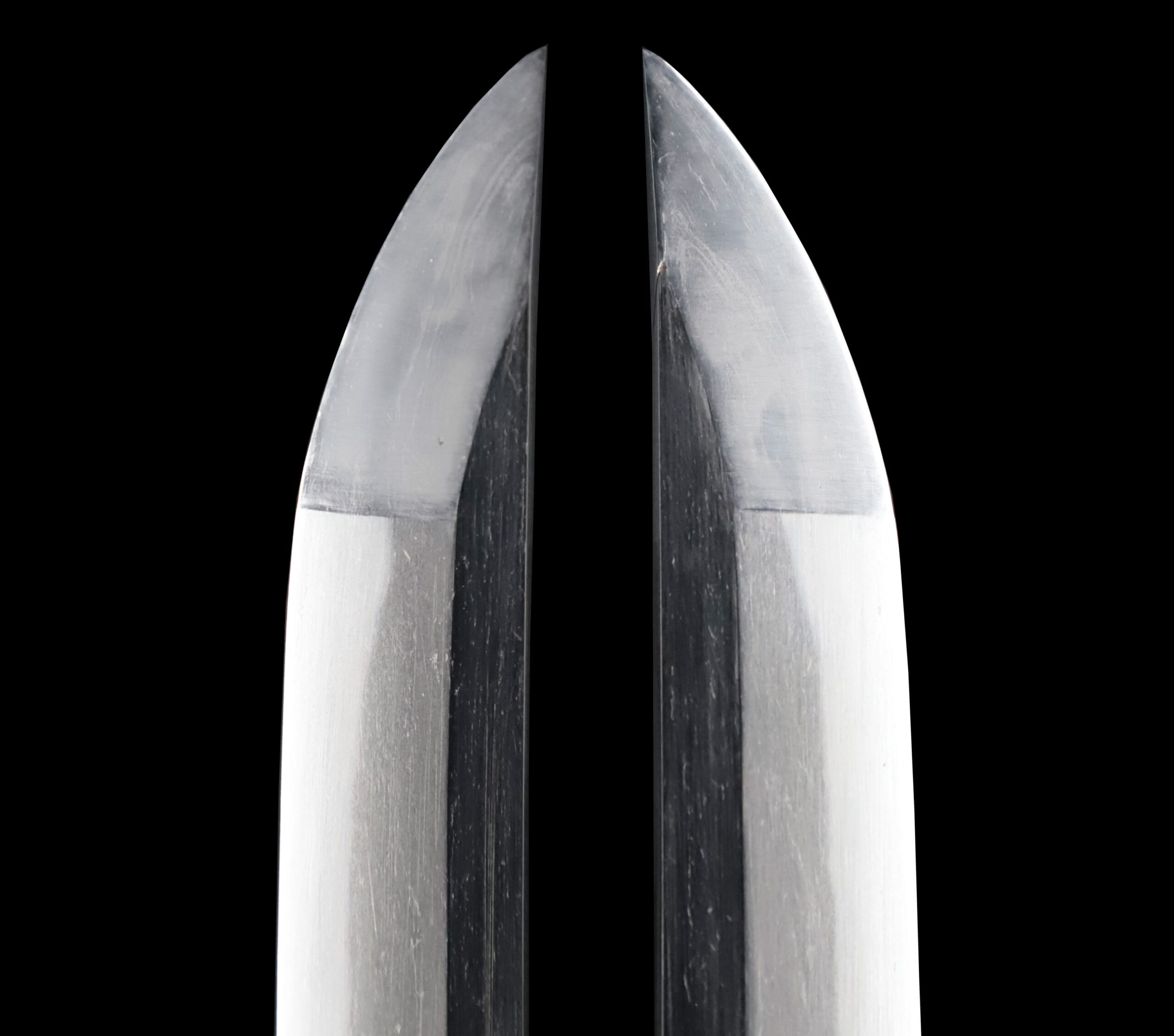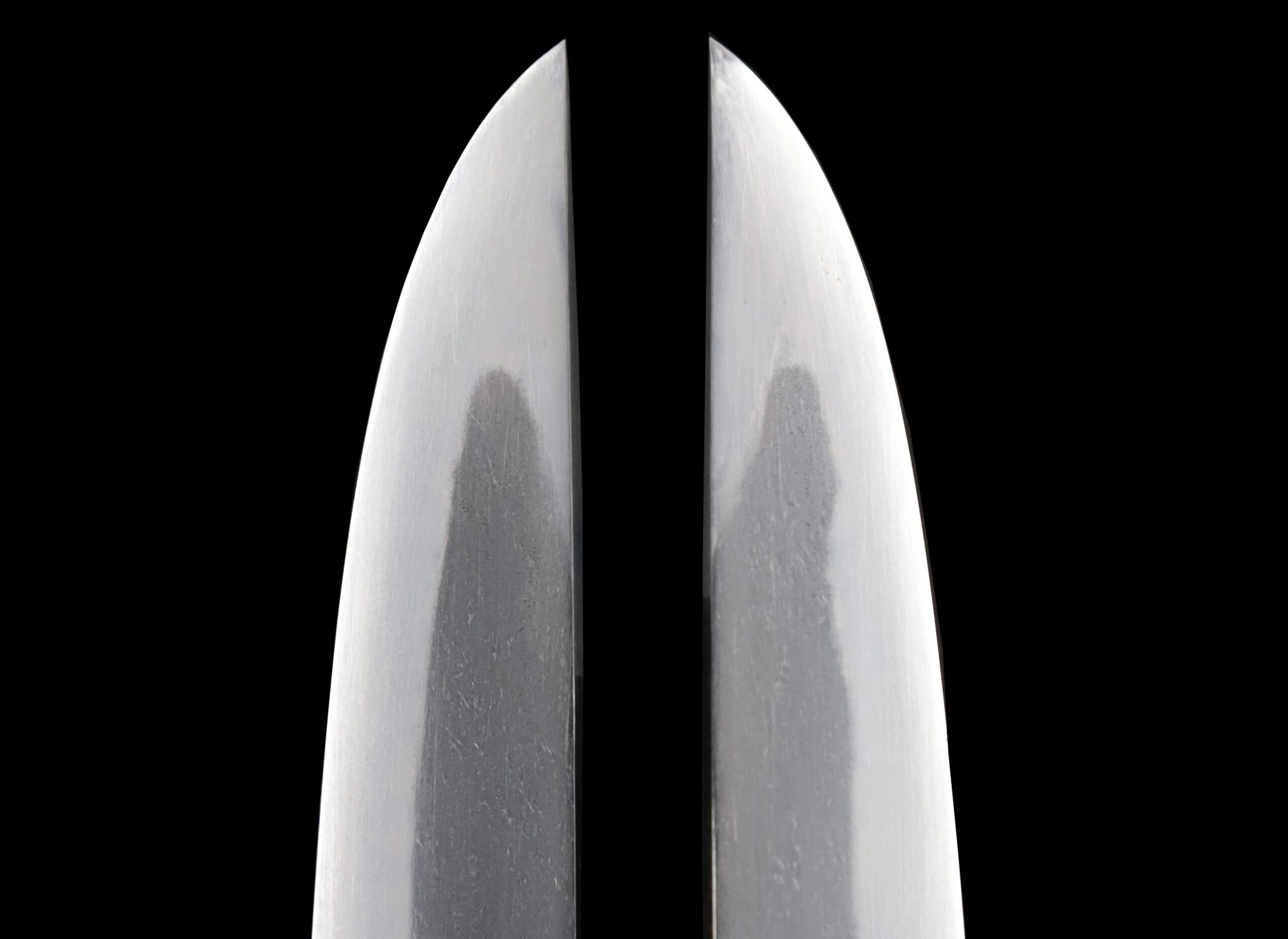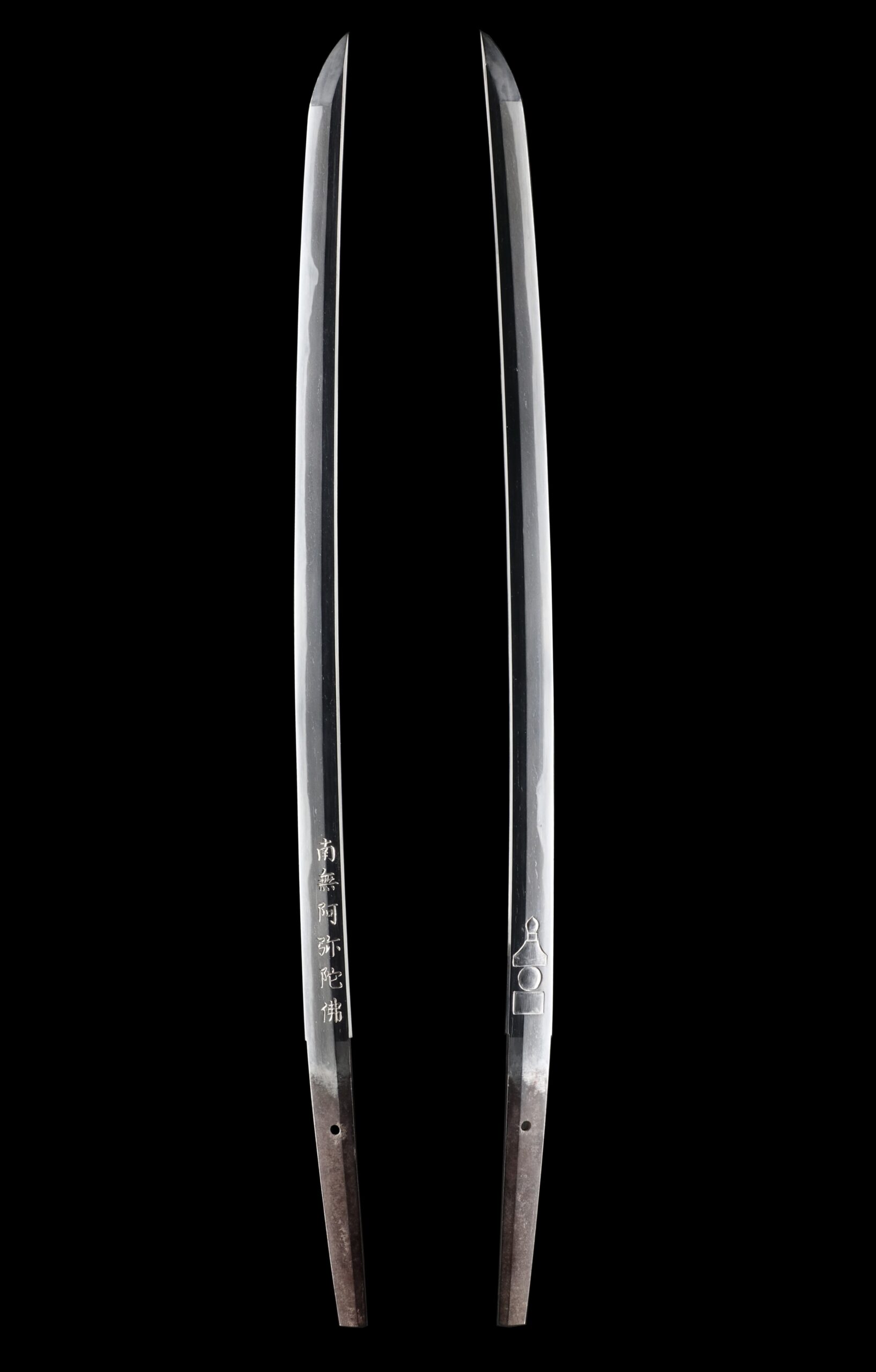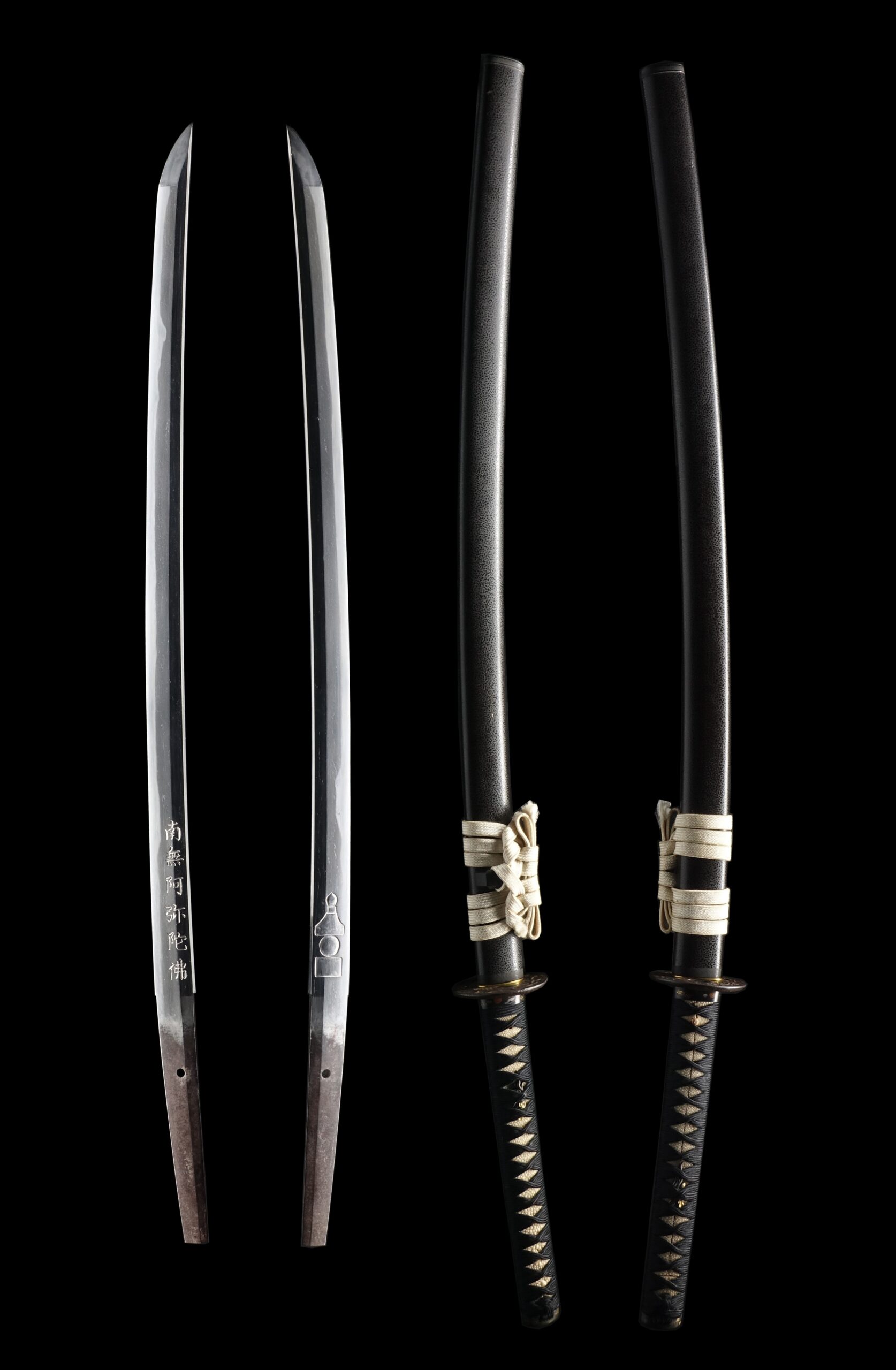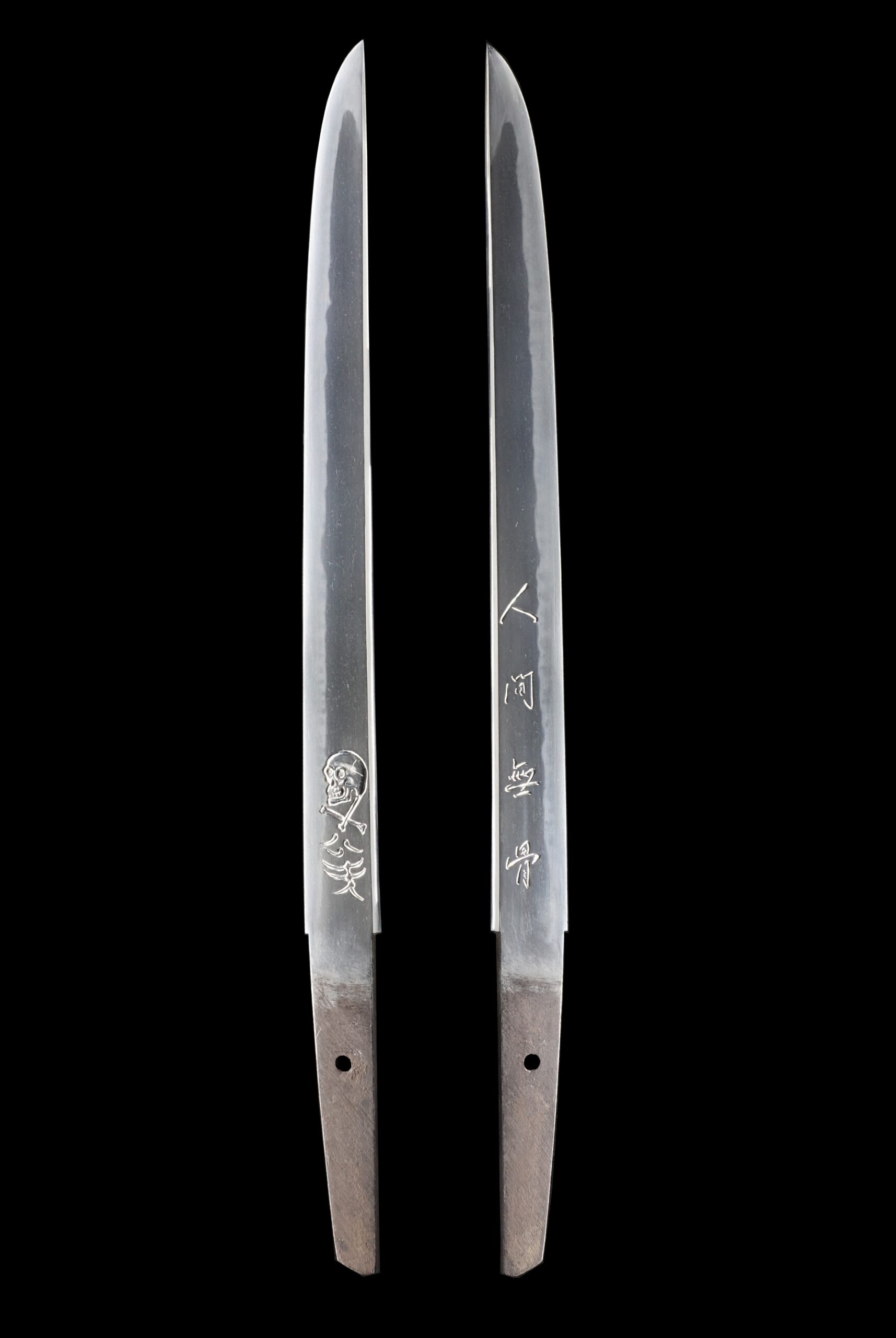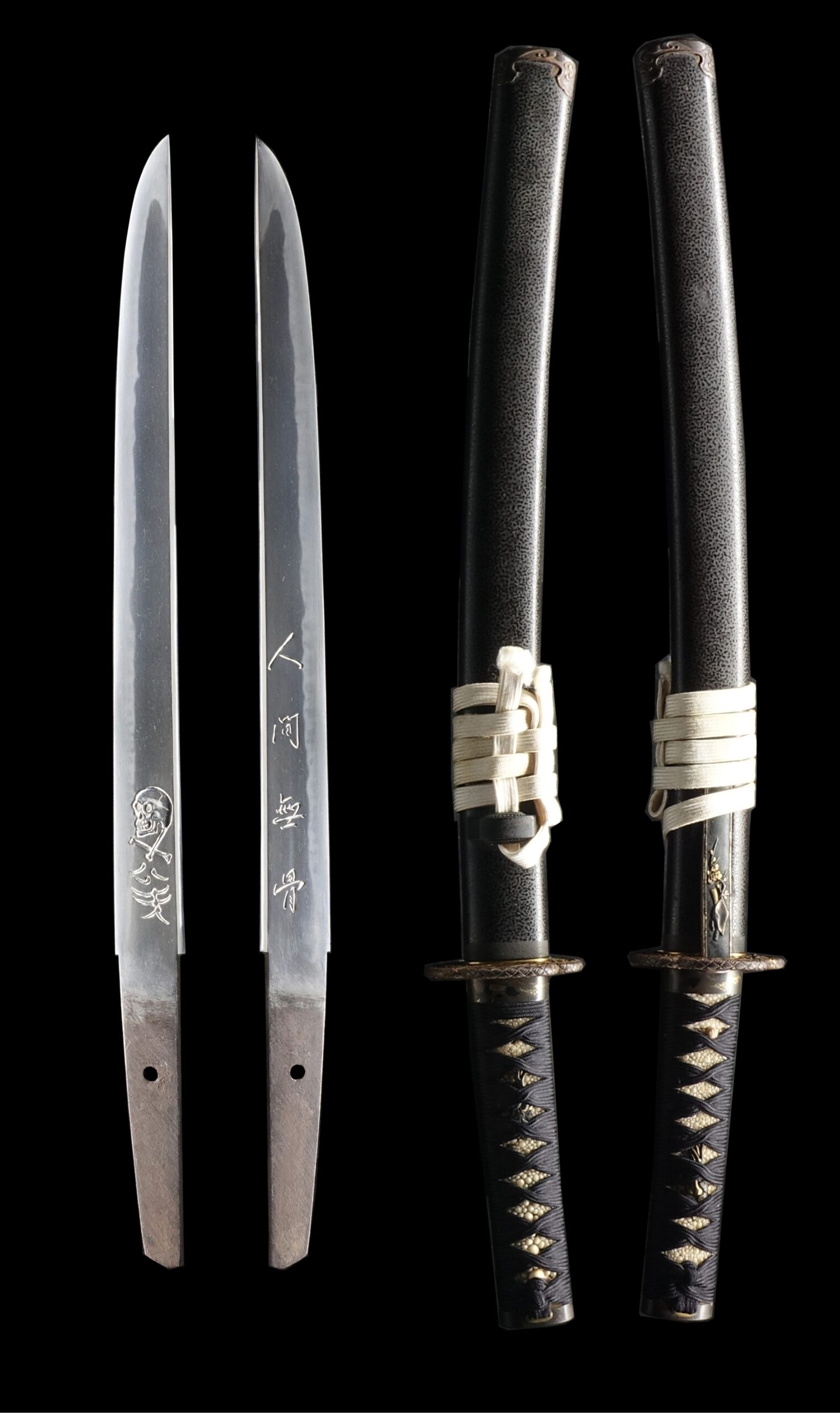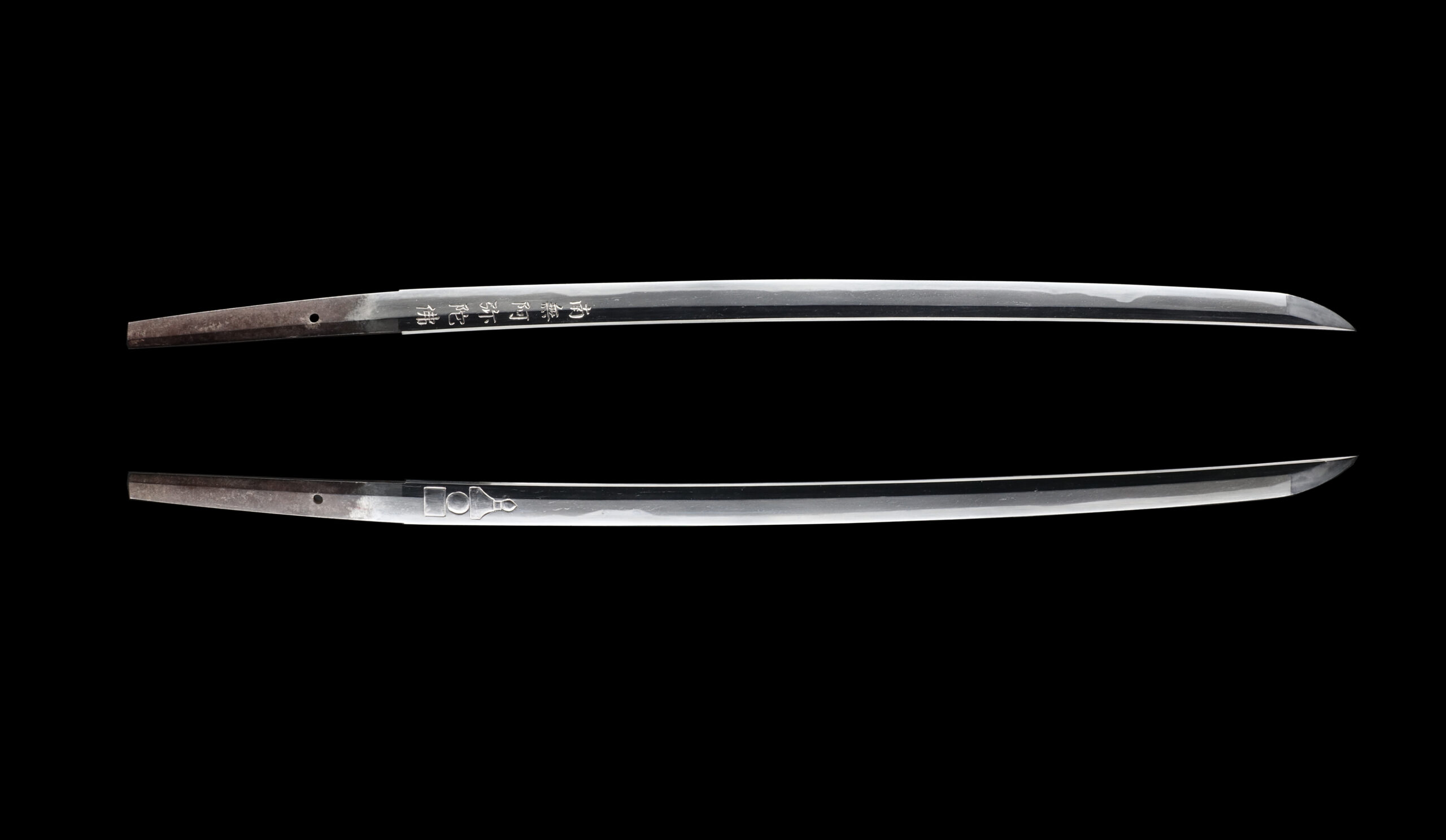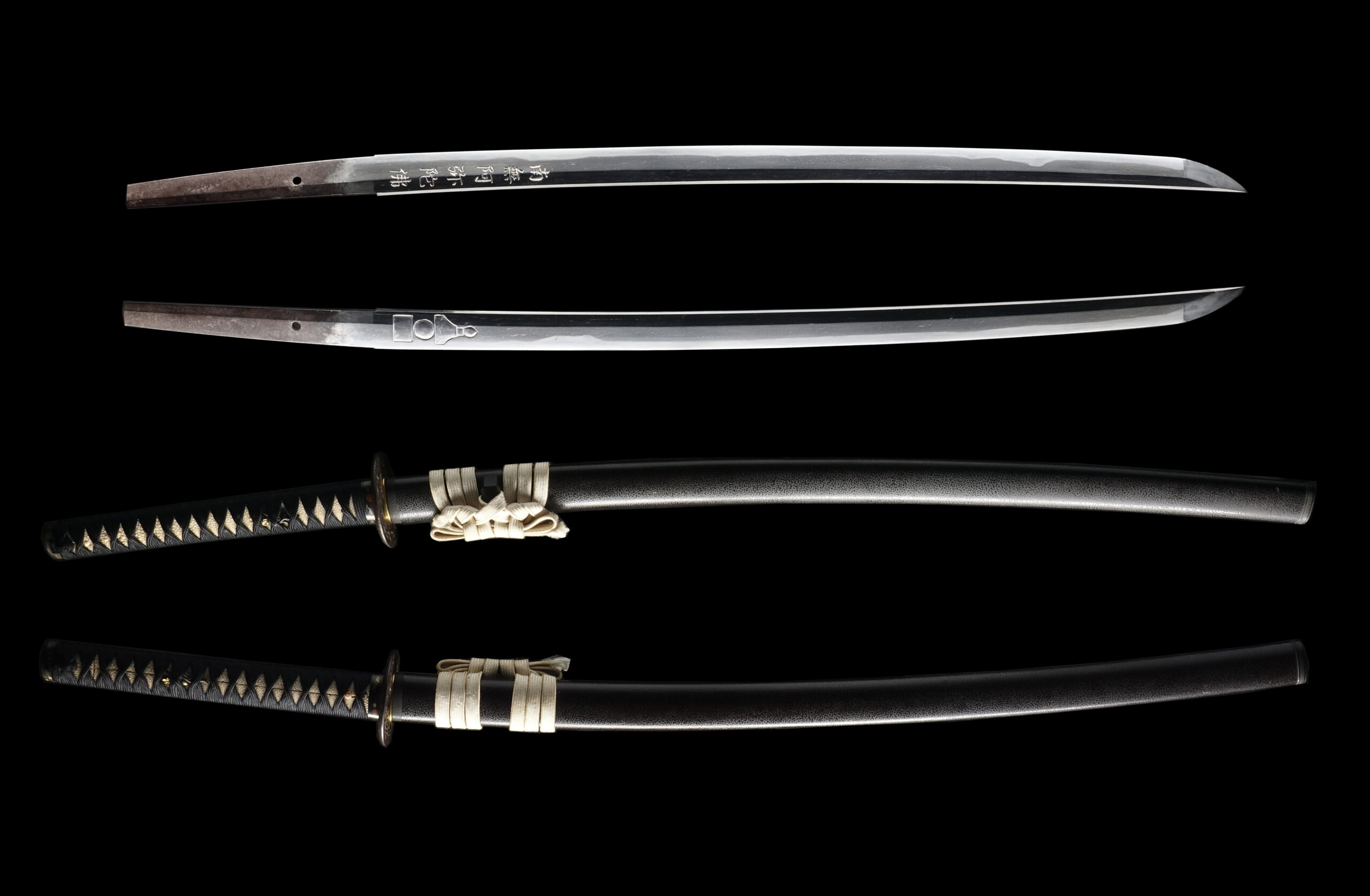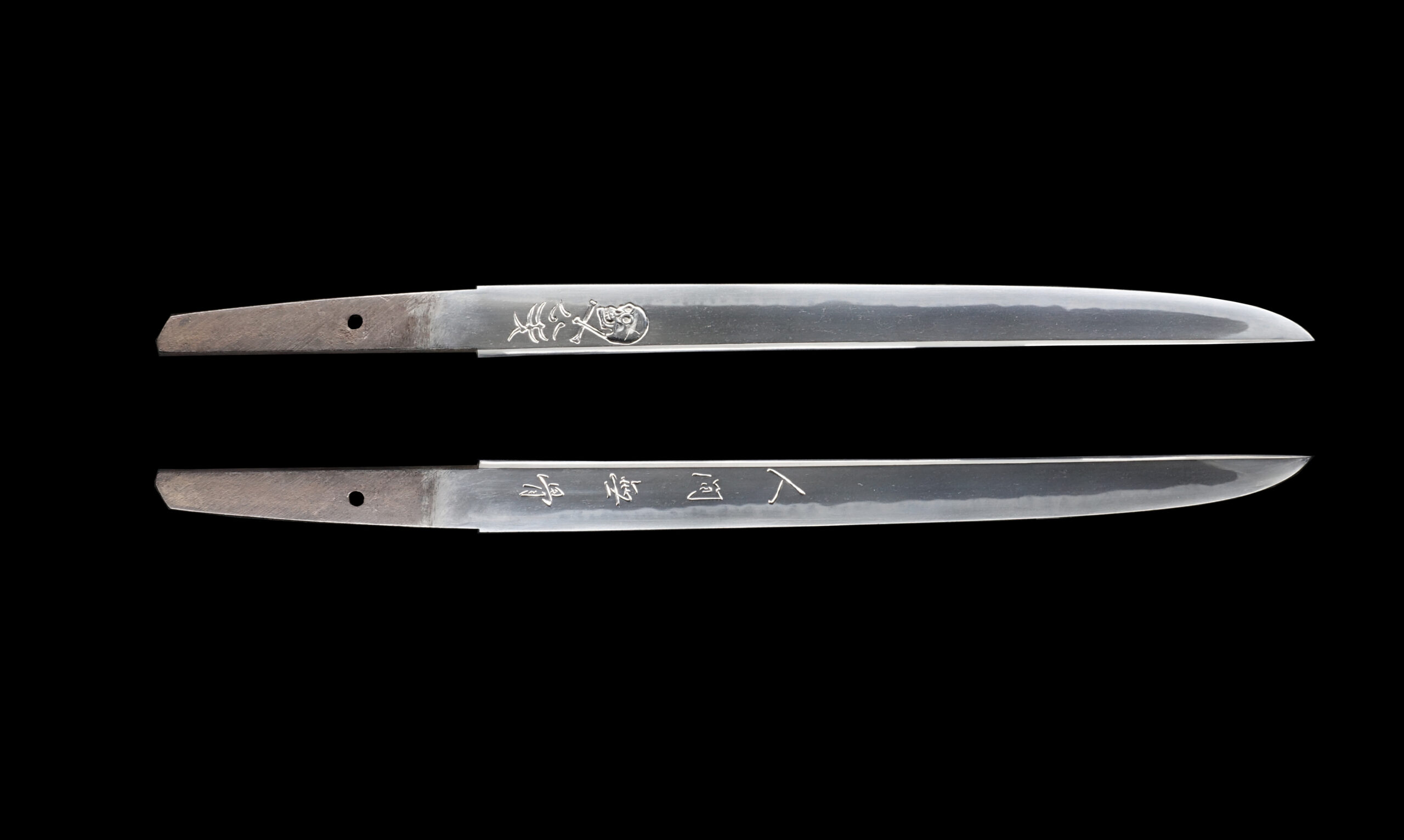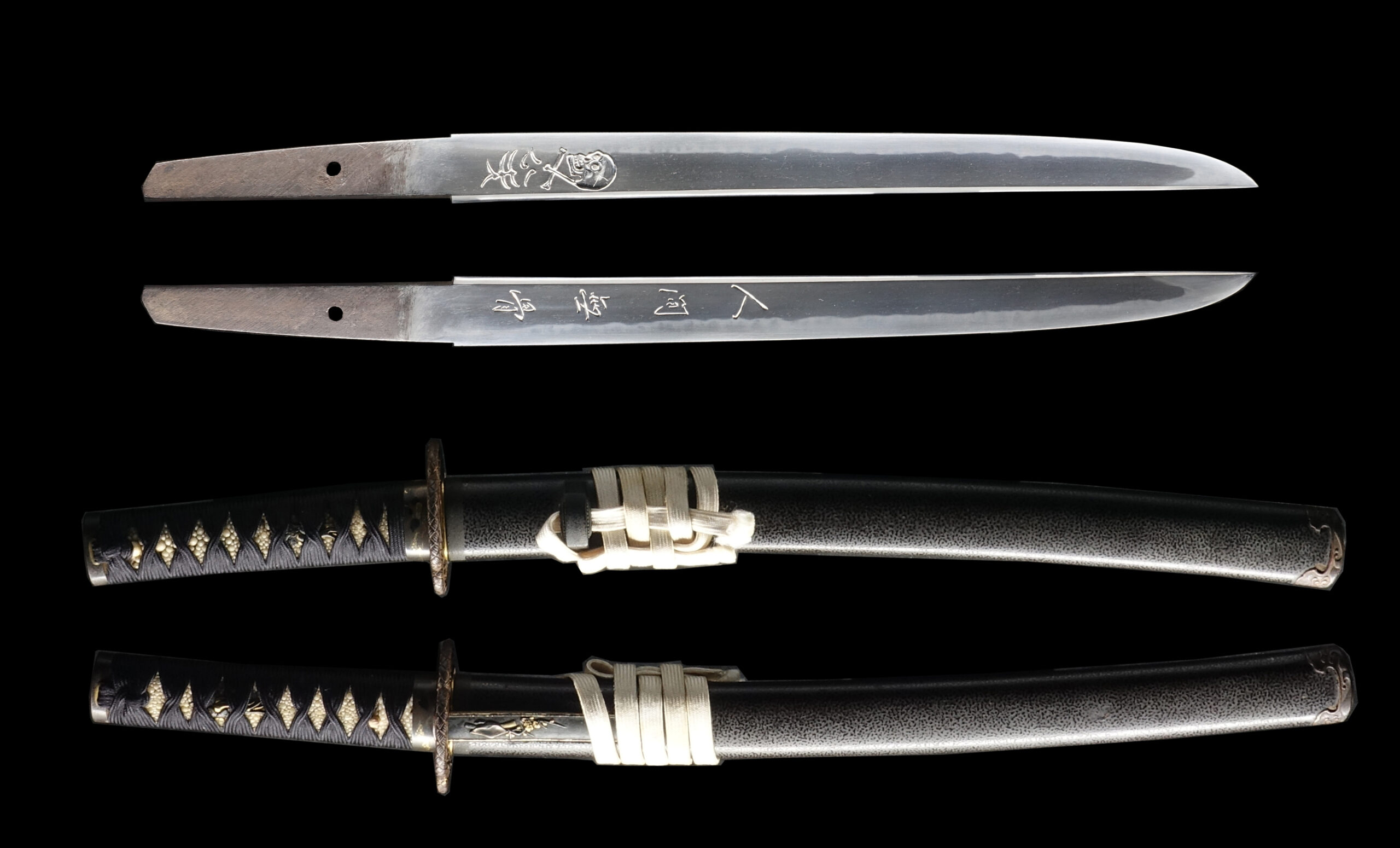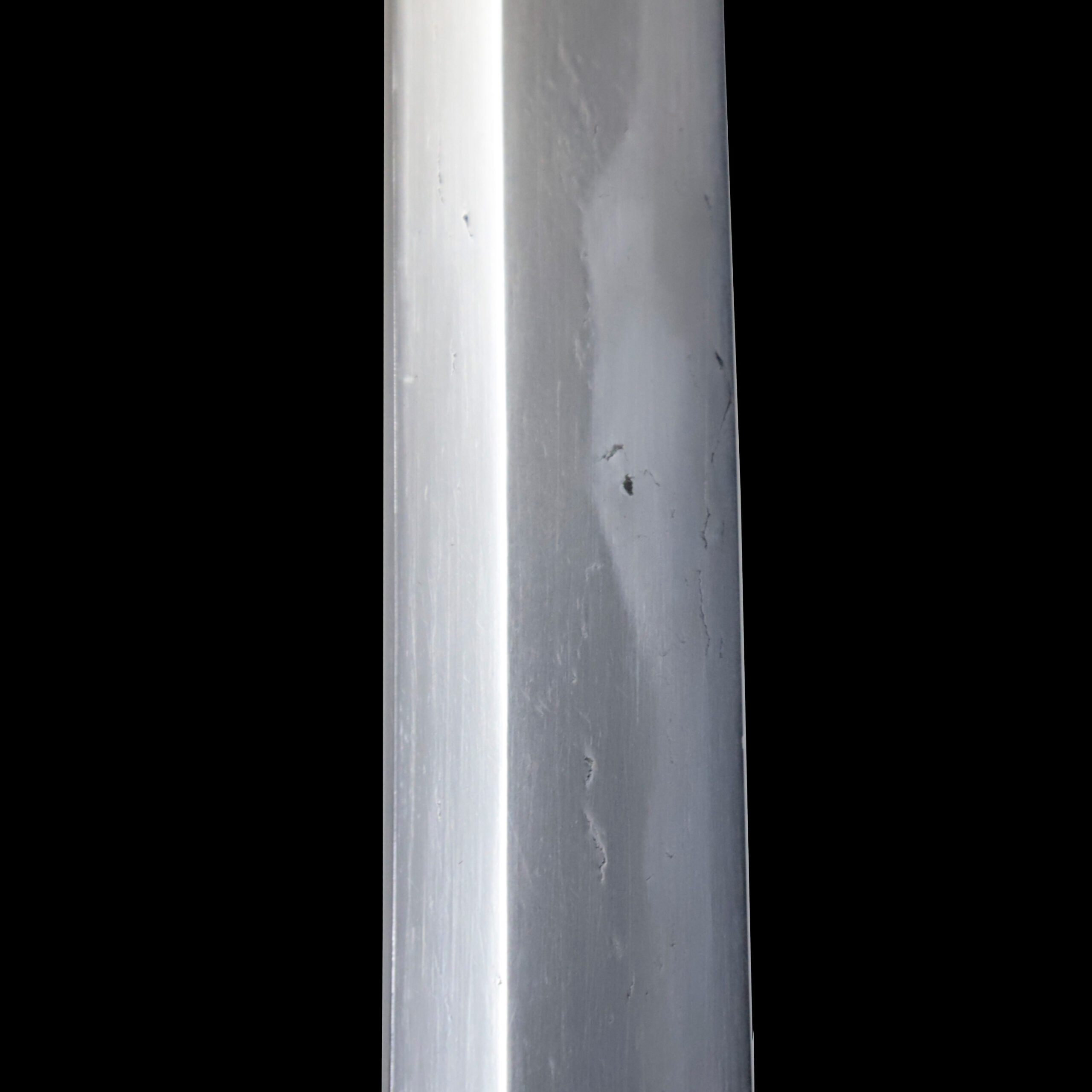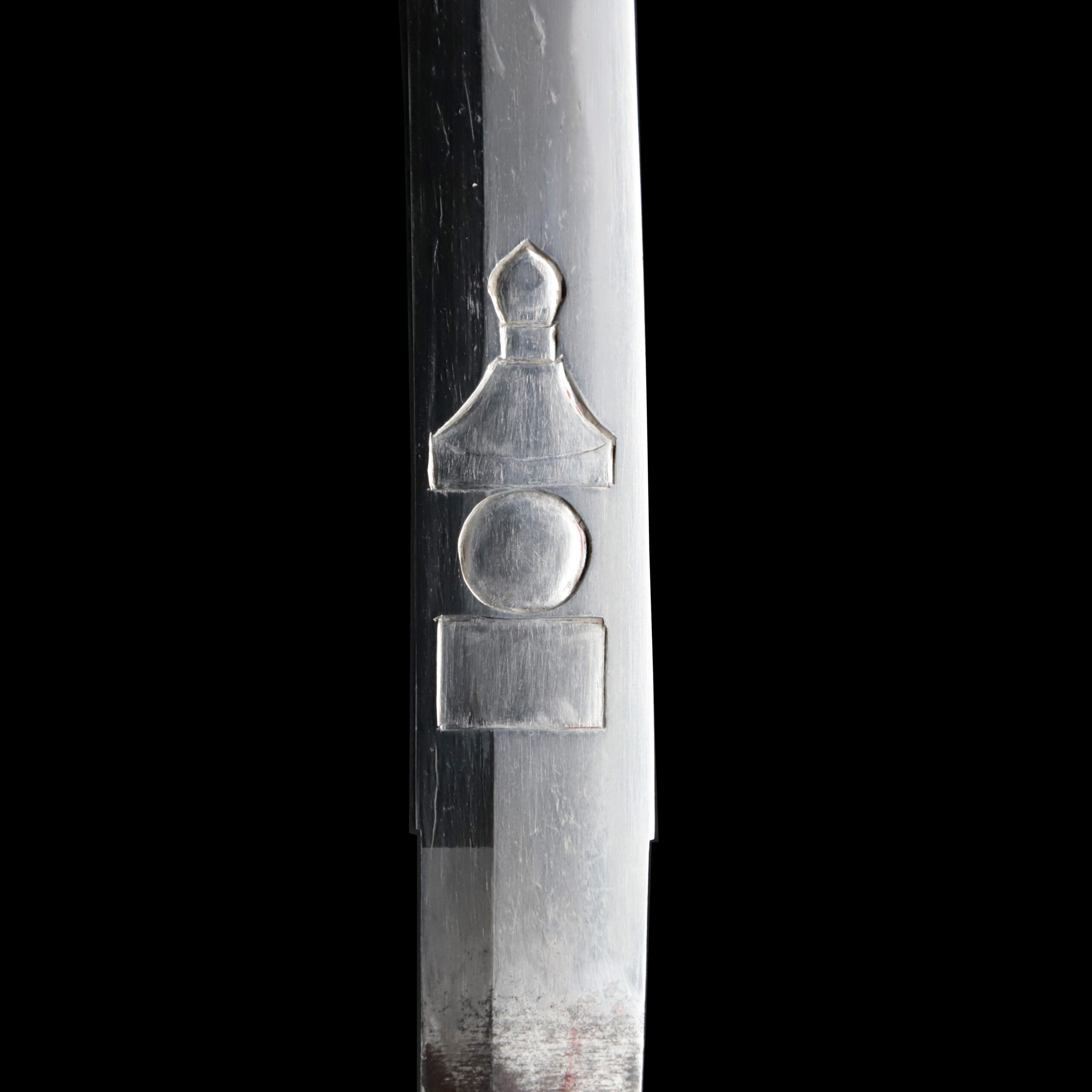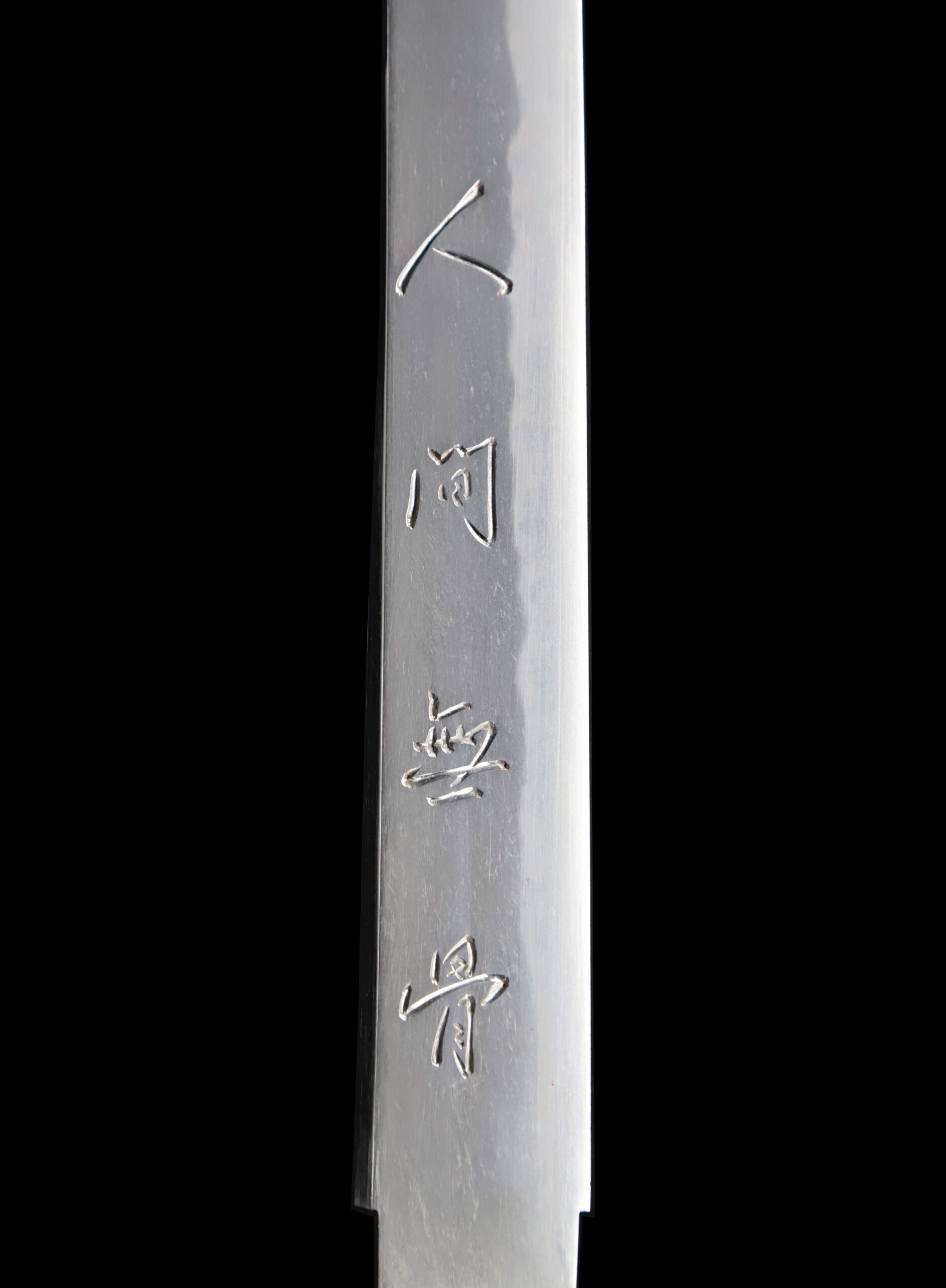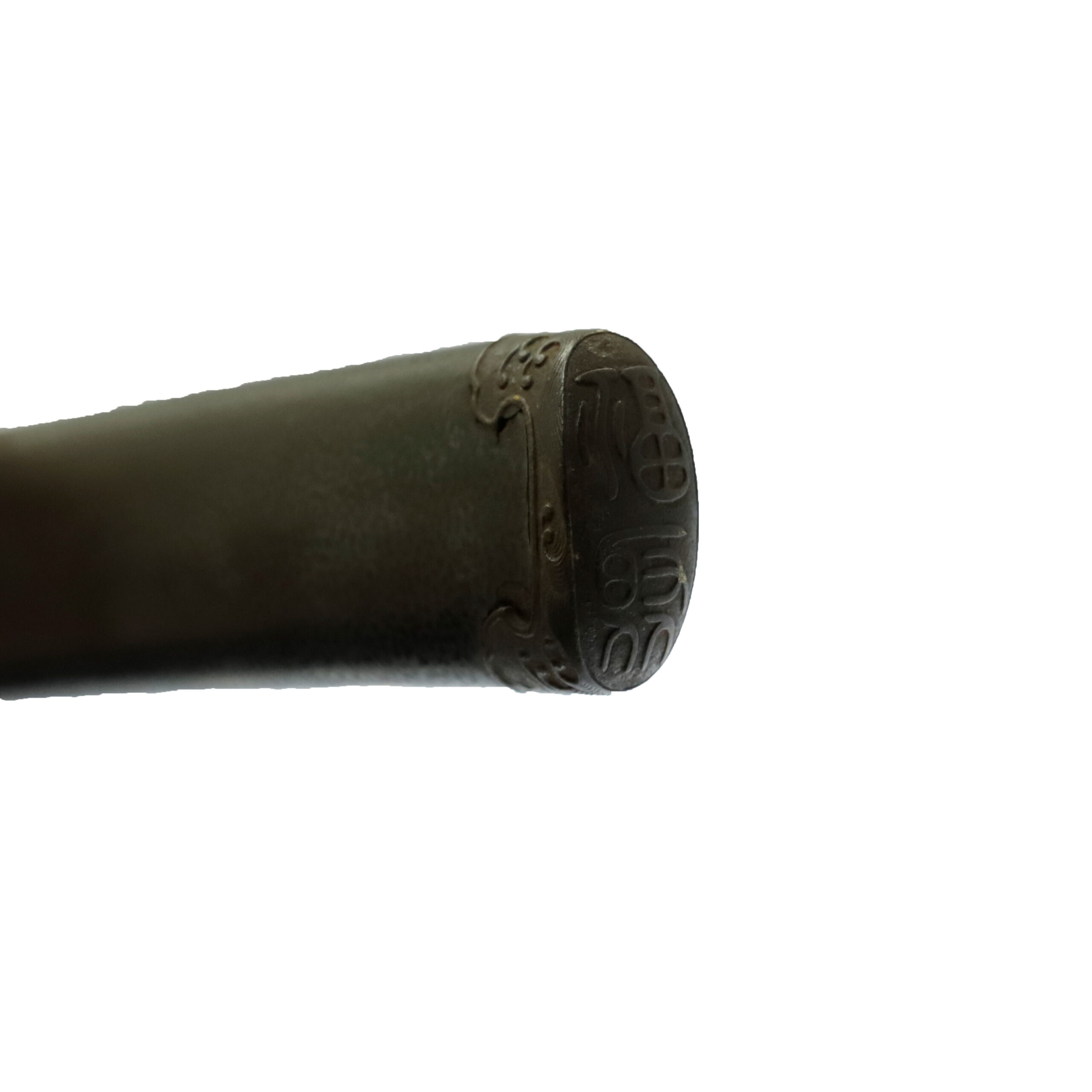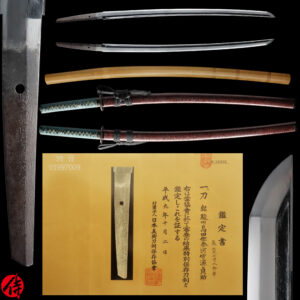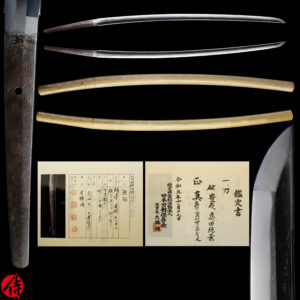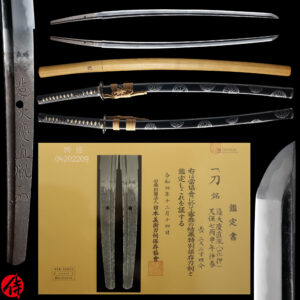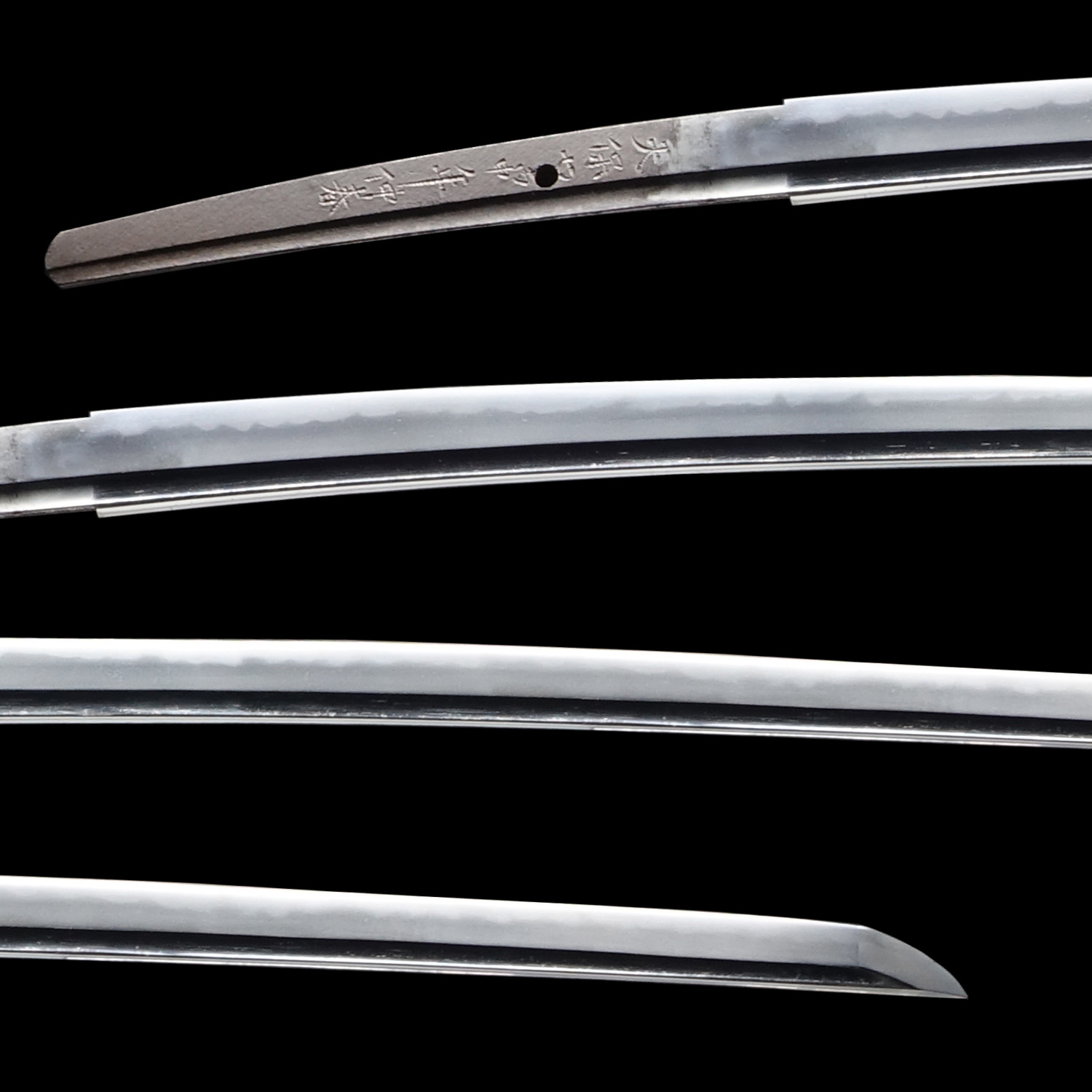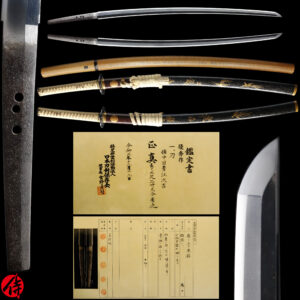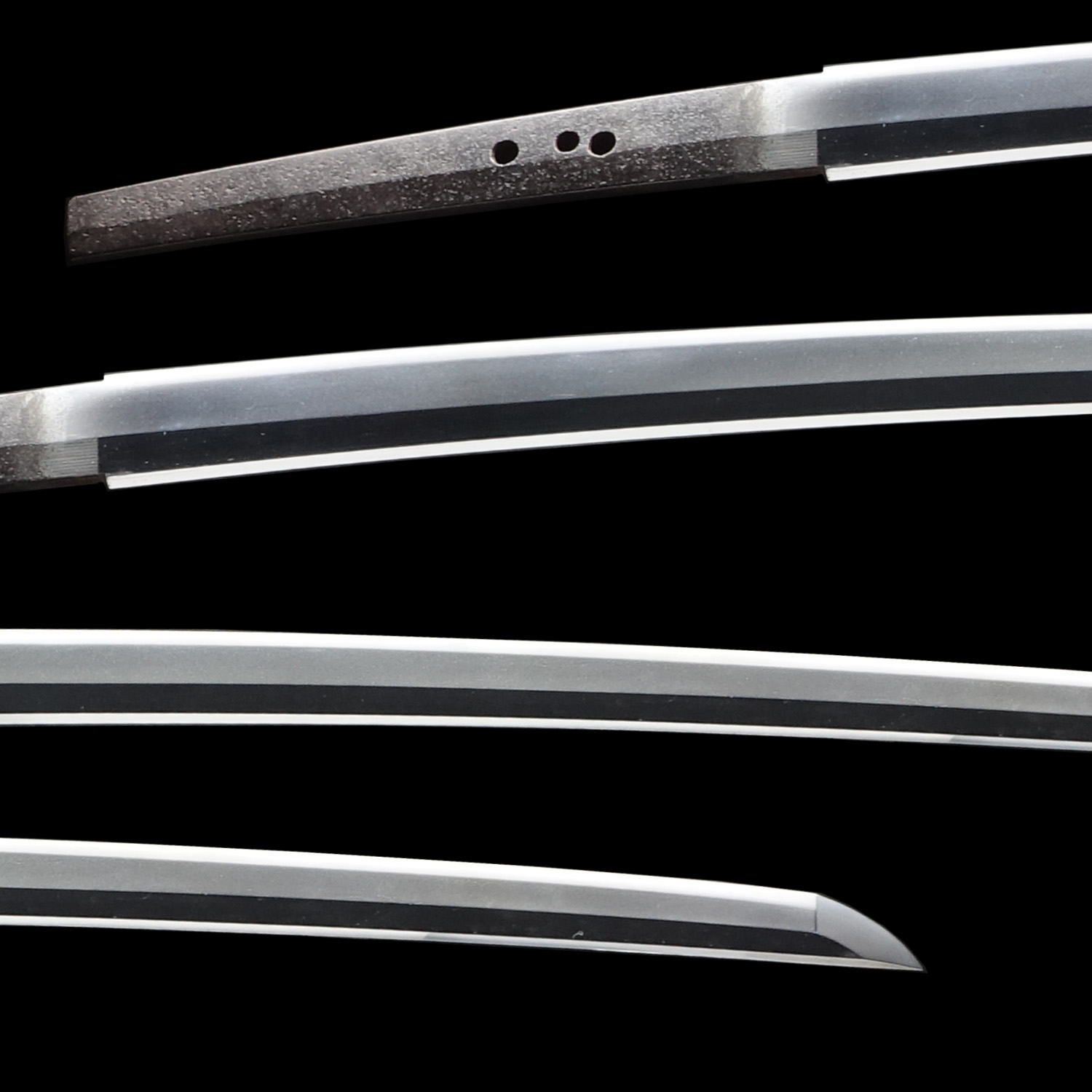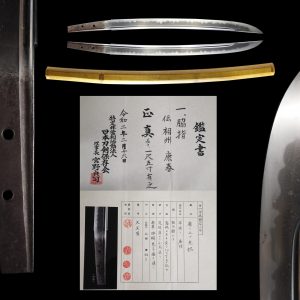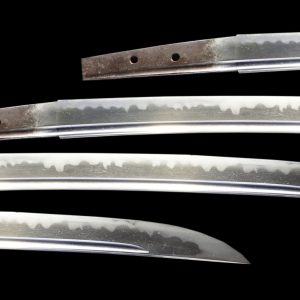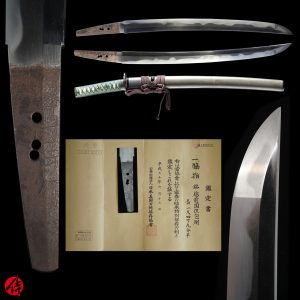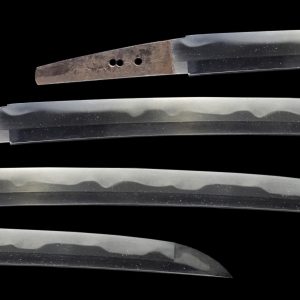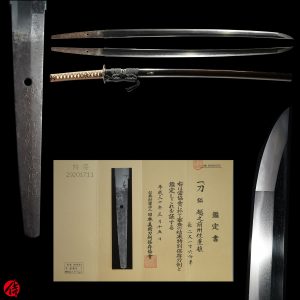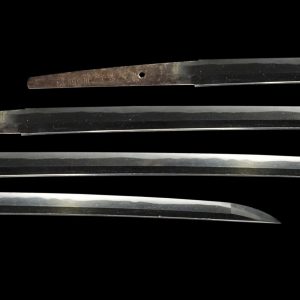Antique Japanese Sword Daisho attributed to Dotanuki Masakuni and Aizu Kanesada with NTHK Kanteisho Certificate
【Description】
■Katana
This blade is attributed to Dotanuki Masakuni (同田貫正国), who was active during the Tesho era (1573-1592: Azuchi Momoyama period) in Higo domain (Today’s Kumamoto prefecture). Dotanuki is a school founded by Masakuni. He served Kato Kiyomasa (加藤清正), who ruled Higo domain as a feudal lord.
It is said that Masakuni was a descendant of the Enjyu school that had forged blades for the Kikuchi family and flourished during the late Kamakura period-Nanbokucho period (Late 13th-Early 14th century). Kikuchi clan ruled the Higo domain for a long time, but the clan left the place at the end of the Muromachi period (late 15th-early 16th century). The influence of Enjyu school diminished. Eventually, the Fujiwara Kunikatsu and Nobuyoshi brothers, who belonged to a branch of the Enjyu school, revitalized the school by moving to a place called Dotanuki and forged blades. Their craftsmanship was acknowledged by Kato Kiyomasa, one of the most powerful feudal lords during the warring state period. They received one letter from their lord Kiyomasa (Kiyo and Masa). Nobuyoshi changed his name to Masakuni (正国), and his older brother changed his name to Kiyokuni (清国). Masakuni founded the Dotakuni school under the auspice of the Kato clan.
*Please keep in mind that there is noticeable Kizu on the Mune and Shinogiji part near the Kissaki (the tip area). We uploaded a photo of this area. If you like to see more detailed condition from different angles, we will take more photos and send them you if requested.
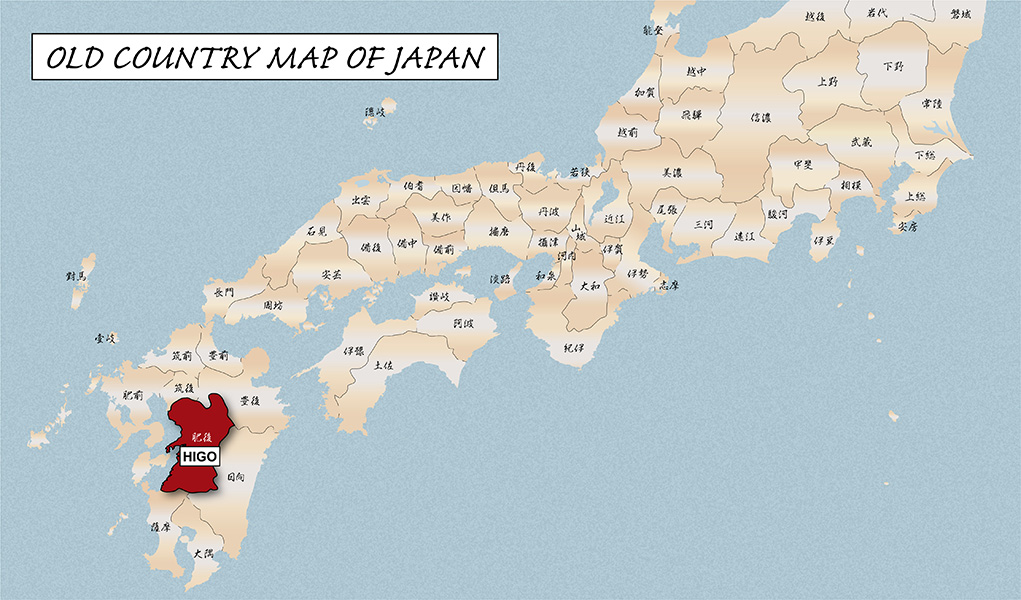

■Wakizashi
This blade is attributed to Oshu Aizu Kanesada (奥州会津兼定), who was active during the Tenpo era (1831-1845:Late Edo period) in Oshu province (today’s Fukushima prefecture). Based on its NTHK appraisal, we believe the attribution was given to the 10th-gen Aizu Kanesada. His son was Izumi no Kami Kanesada (和泉守兼定).
Aizu Kanesada school was founded by Kanesada, who had forged swords in Mino province (Today’s Gifu prefecture) until the Keicho era(1596-1615). This Kanesada was the grandson of Noshu Izumi no Kami Kanesada(濃州和泉守兼定), a renowned swordsmith in Mino province. Kanesada relocated to Aizu from Mino to serve Gamo Ujisato(蒲生氏郷), a powerful feudal lord who worked for Oda Nobunaga. And, Kanesada founded Aizu Kanesada school there. Aizu Kanesada school lasted 11th generation by the end of the Edo period. The generations of Kanesada forged swords for the Aizu domain in Fukushima Prefecture.
■What is Daisho?
Daisho is a pair of two Japanese swords Samurai carried. During the Edo period, having Daisho in public places was considered social status for Samurai. Furthermore, Samurai were required to wear them under the law back then. Daisho is written as 大=Big and 小=Small. Dai part means Katana, and Sho part means Wakizashi.
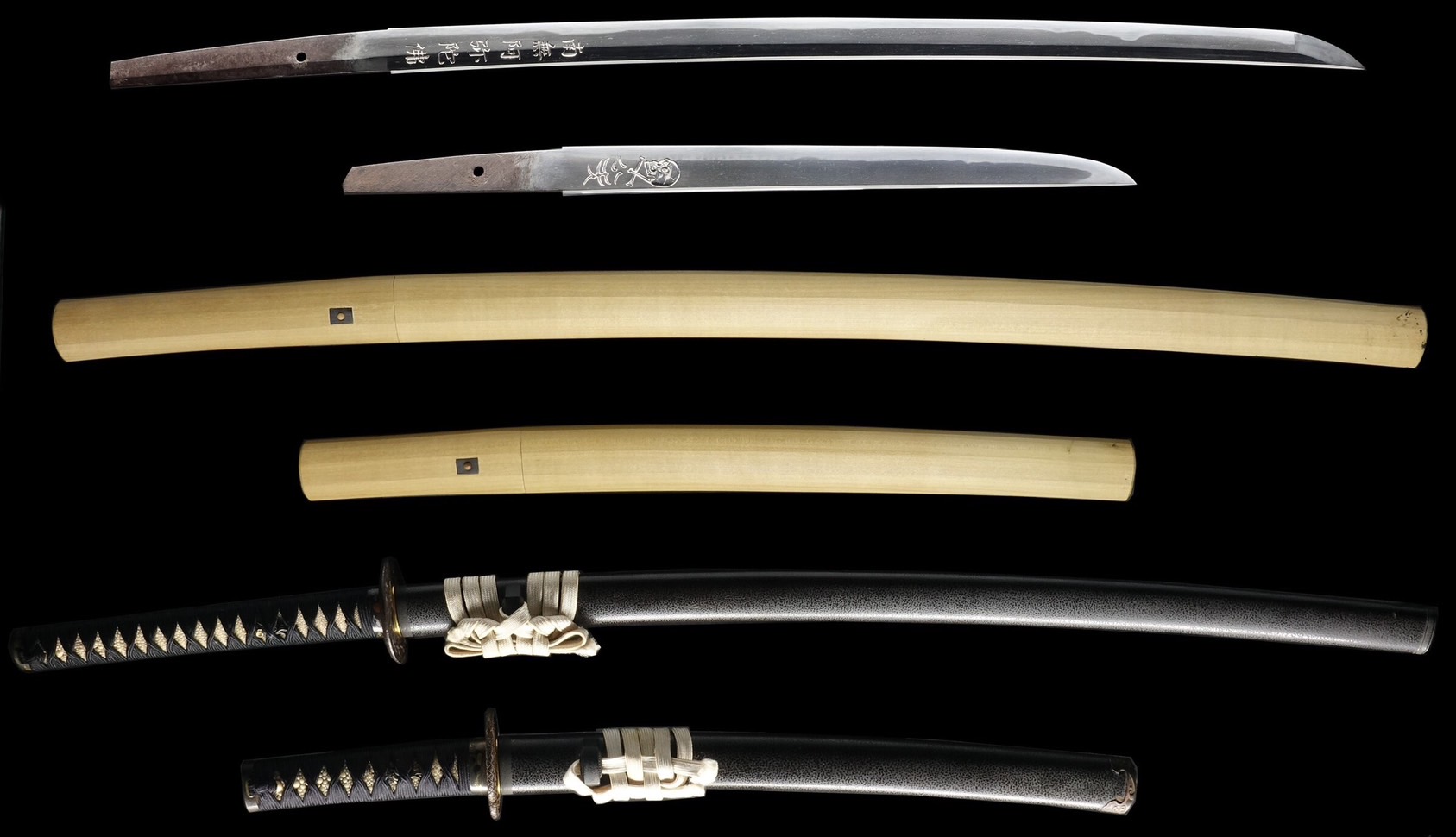
Horimono (Engraving)
There is a Horimono on both Katana and Wakizashi. On one side of the Katana, you can see engraving of Namu Ami Dabutsu (南無阿弥陀仏). It is the prayer to the Buddha (仏陀). Followers wished to be born into the Pure Land of Perfect Bliss by saying a prayer to the Buddha. The former owner of this blade might have been a devout person.
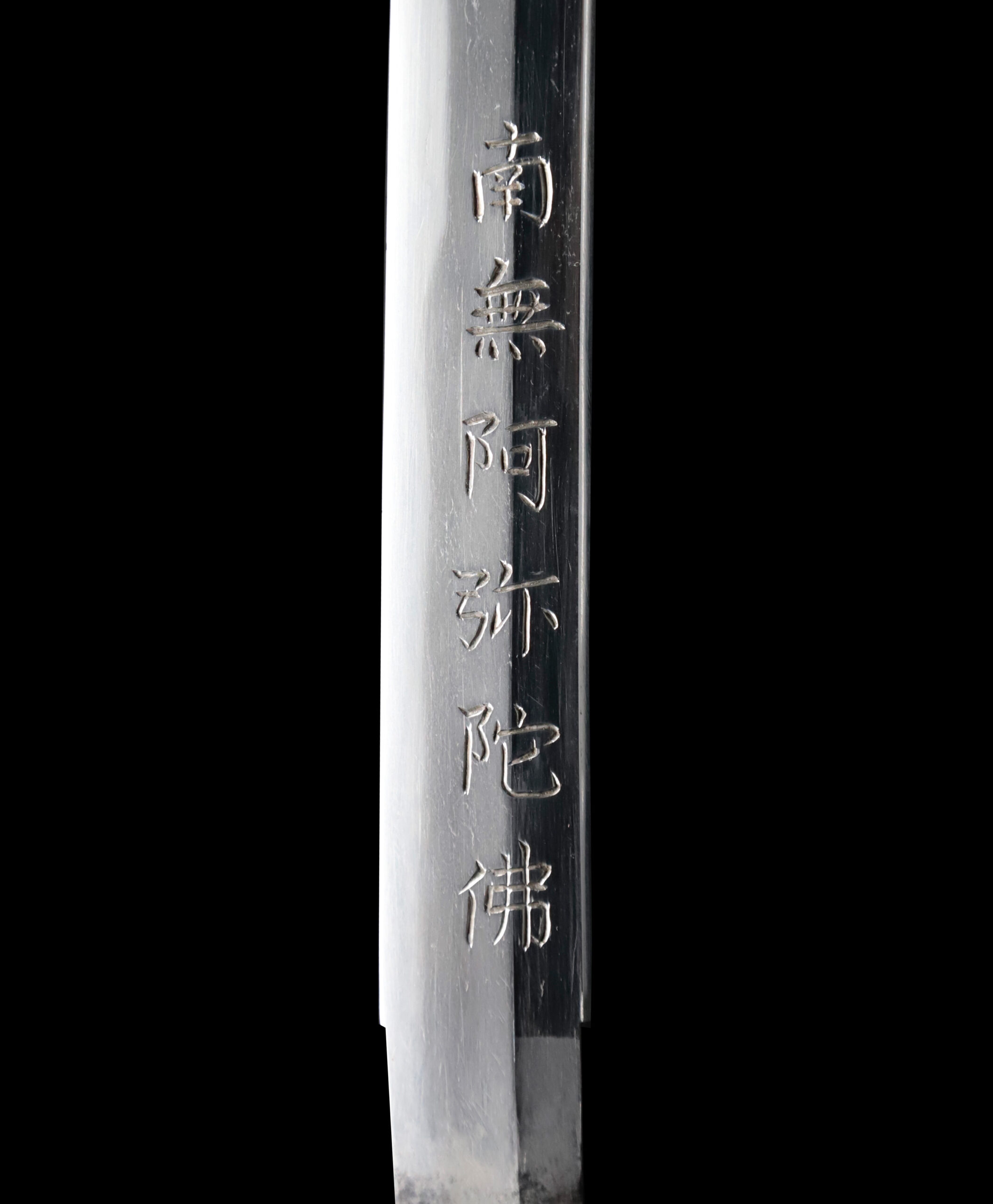
One side shows a skull of human. This kind of design is called Nozarashi (野晒し). It refers to human bones that have been exposed to winds and rain in the open air and turned into skeletons, and it often refers to skulls in particular. This Nozarashi theme has been favored since a long time ago. We could imagine that people in those days had to live in harsher conditions. In addition, Samurai warriors were always on the verge of life and death on the battlefields. We would say this theme reflects on these aspects of society at that time.
It is not just the famous warlords who left their names in history who ran through the world of warfare. Each warrior whose name was not even recorded has their own history. However, after they lost their lives, they were simply left on battlefields and returned to nature. We would say that the Nozarashi-Zu is a subject that makes us feel the transience of nameless and precious lives scattered on battlefields and the transient after wars.
If we write it like this, you might feel melancholy. However, same as other designs, we hope each viewer will enjoy their own interpretation. By incorporating this motif into the sword mountings, Samurai warriors might have roused themselves toward the battlefield or included the desire to spend time with the souls of their former comrades in arms who had already lost their lives.
At first glance, you might feel that the Nozarashi-Zu has a frightening atmosphere, but the fact is that it was incorporated as part of the decoration. And it was treated as one of the elements that boosted the aspect of Japanese swords as a work of art. We interpret that it makes us feel a sense of the high sensitivity of the people of the time. In addition, the finish of each sword mounting is excellent, and the skillful technique of the artisans could be seen everywhere. We hope you appreciate the details of the Koshirae as well as the blade.
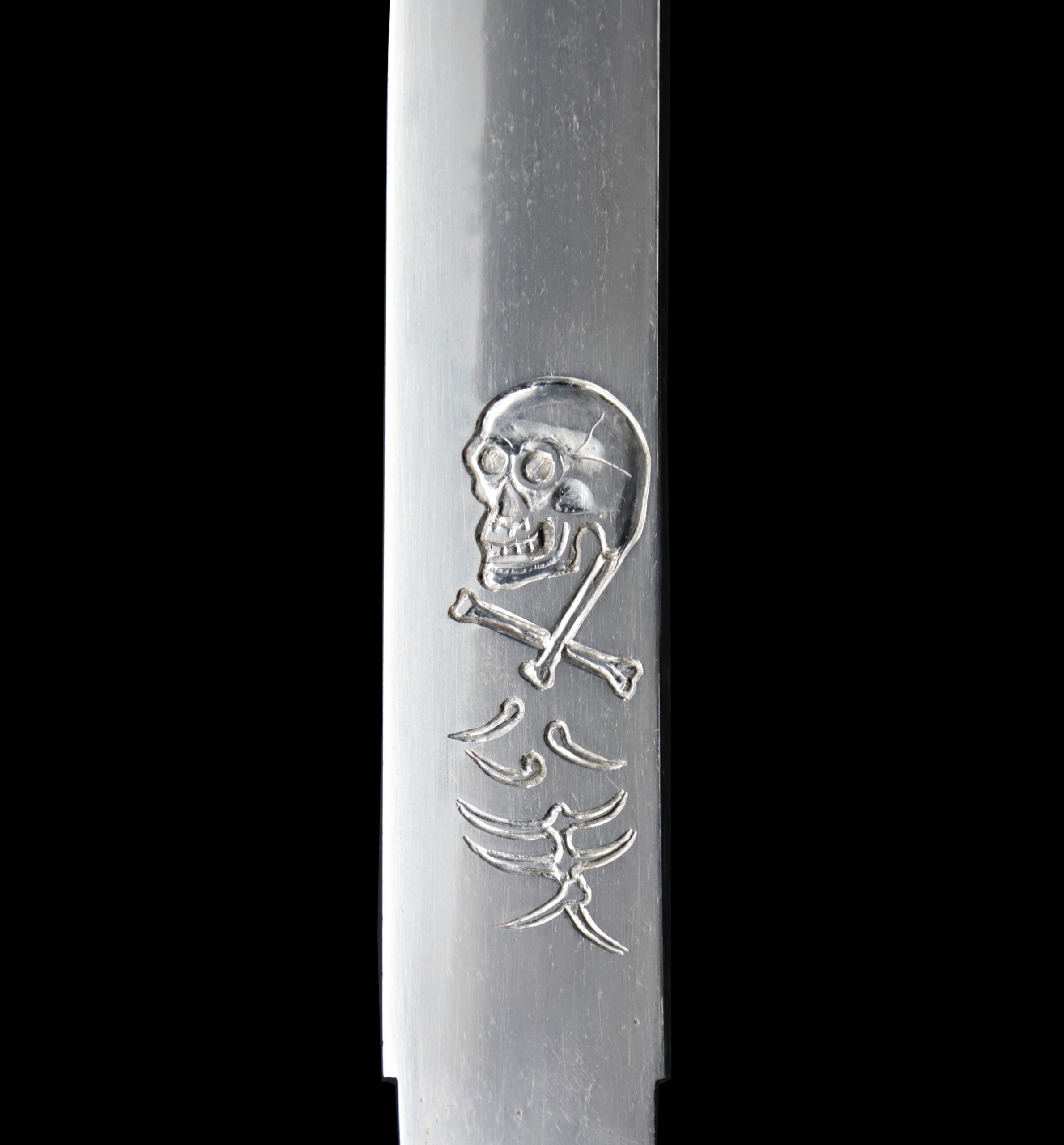
【 Blade】
-Katana
Cutting Edge Length(Nagasa): 60.5 cm (23.8 inches)
Curvature(Sori): 0.8 cm (0.31 inches)

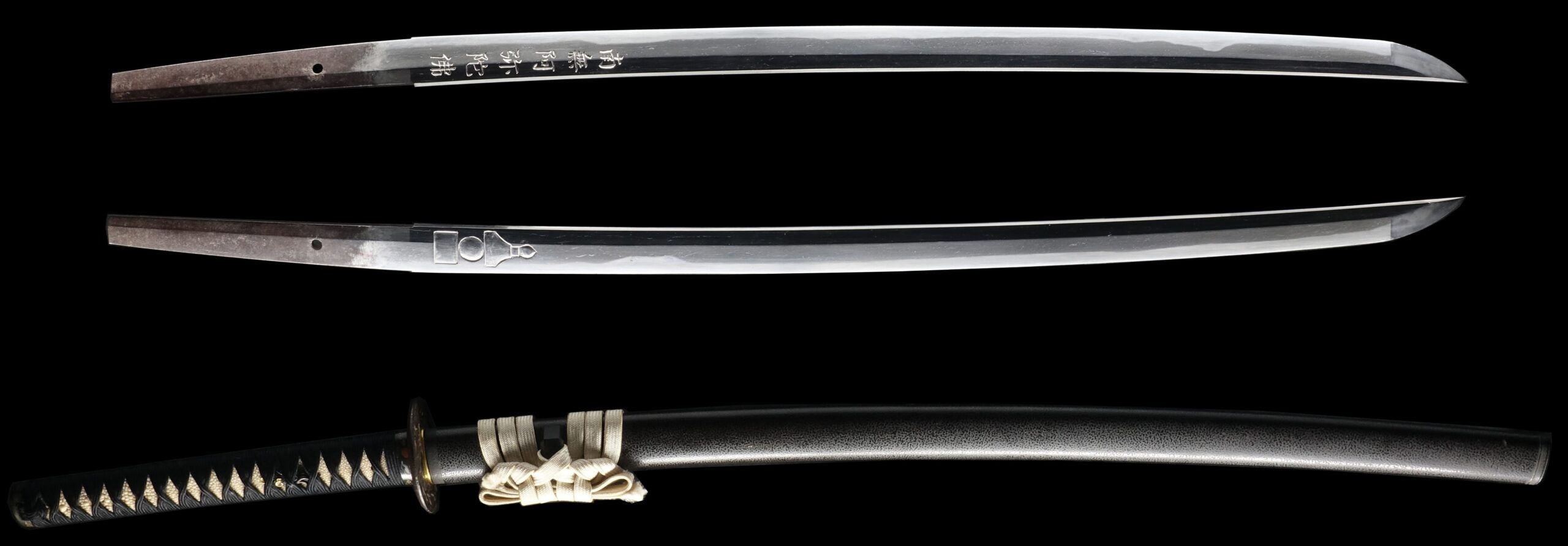
-Wakizashi
Cutting Edge Length(Nagasa):35.5 cm (13.9 inches)
Curvature(Sori):0 cm (0 inches)


Hamon:
The crystalline structure which forms along the cutting edge of a blade as a result of the hardening process
Jimon(Jihada):
visible steel surface pattern created by folding and hammering during forging process
-Katana
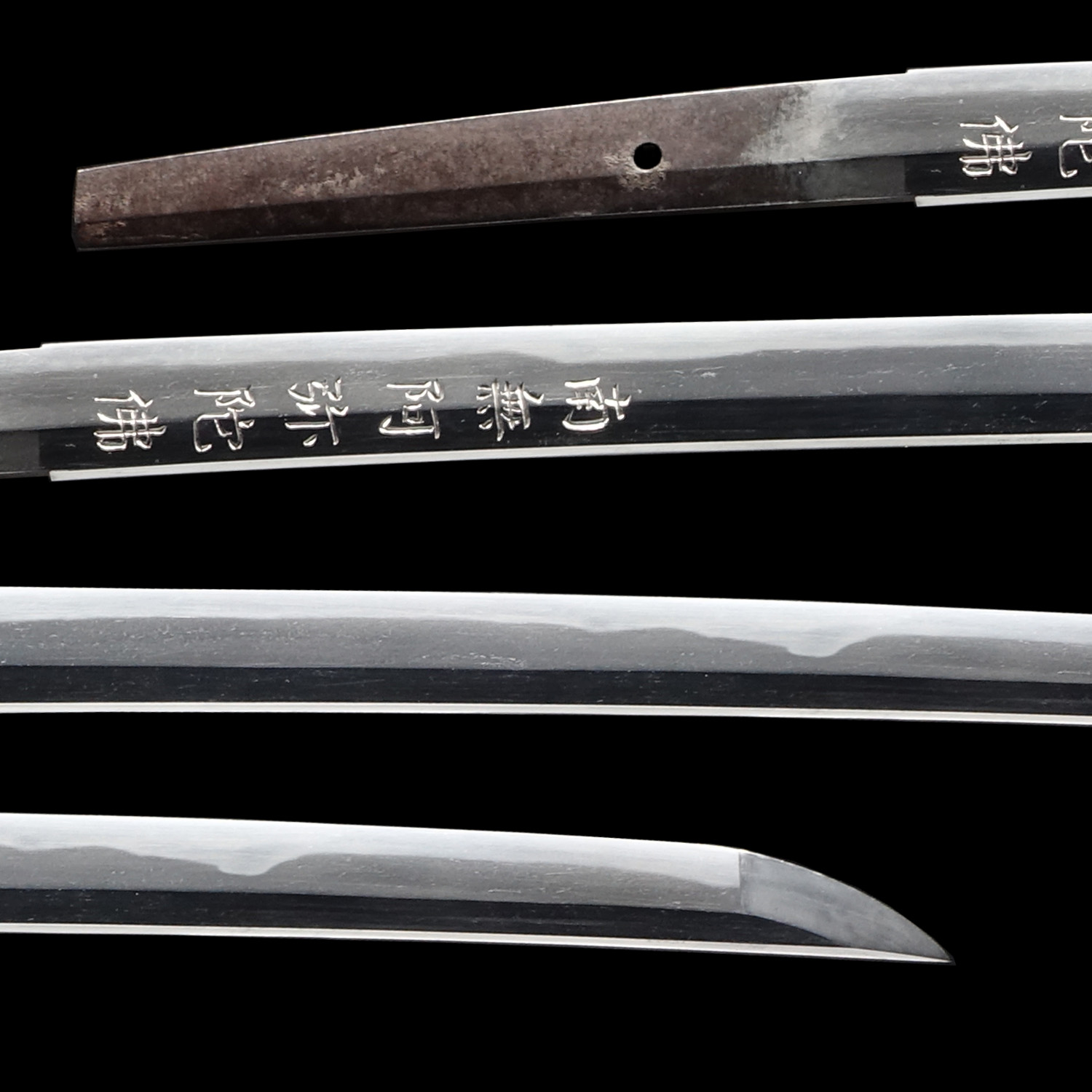

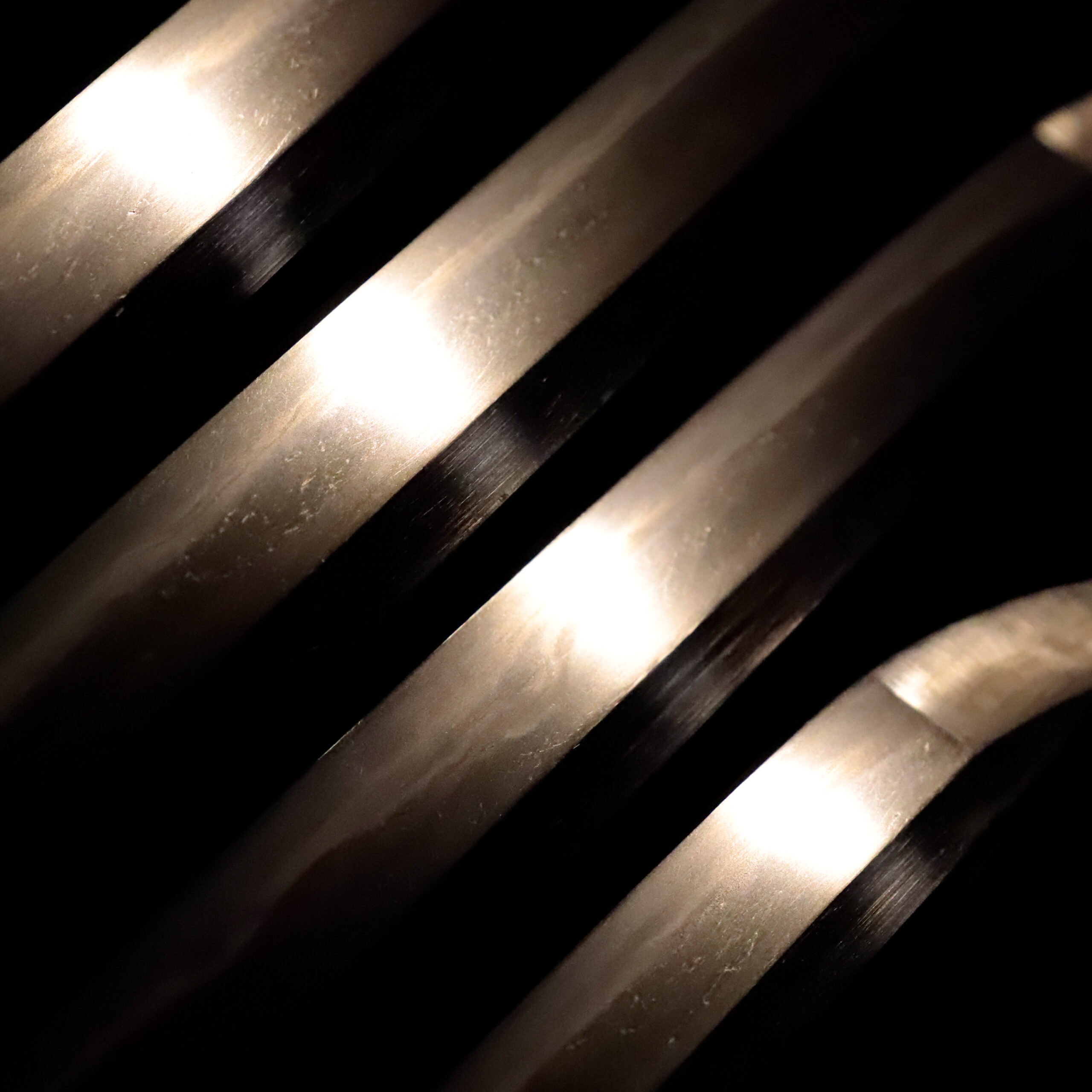
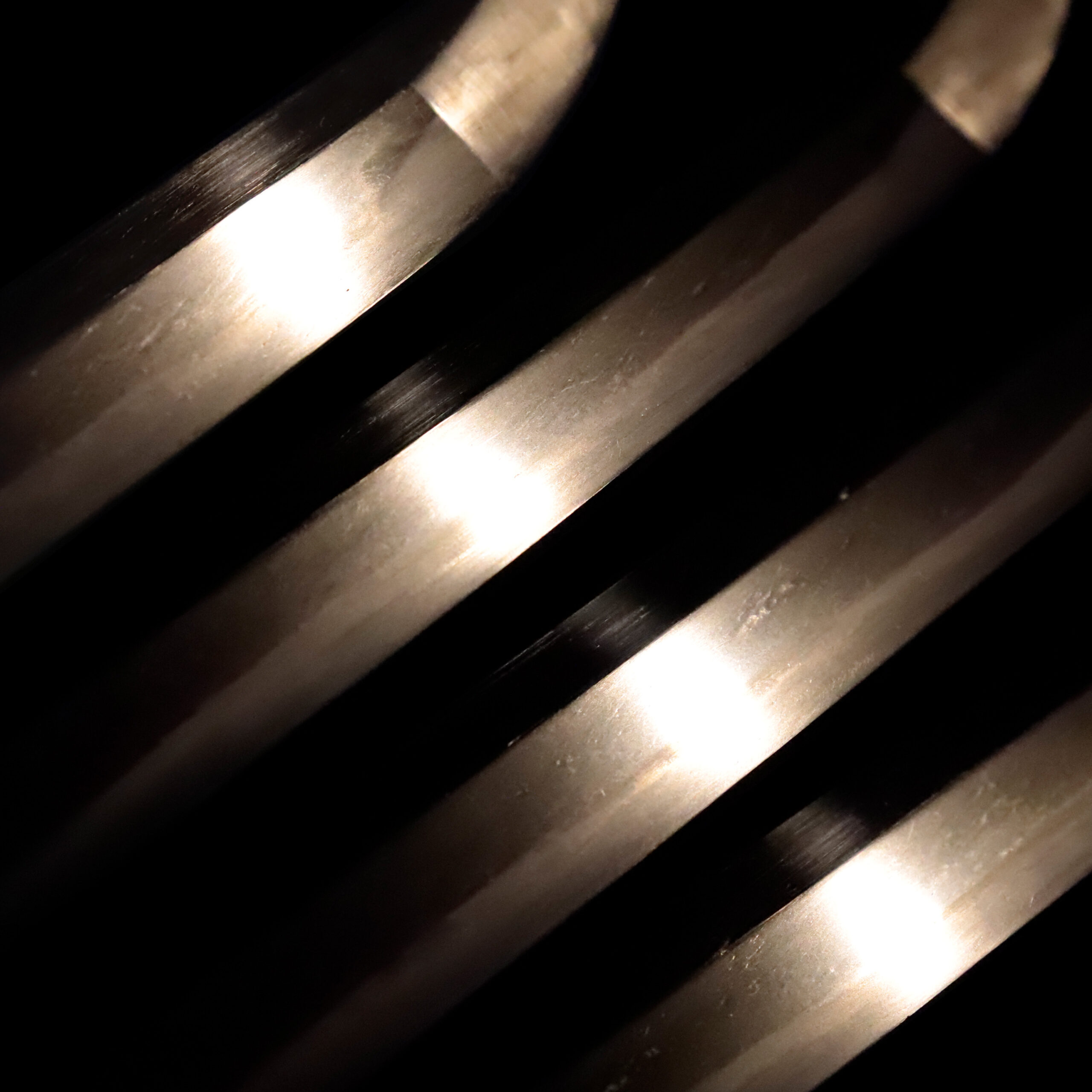
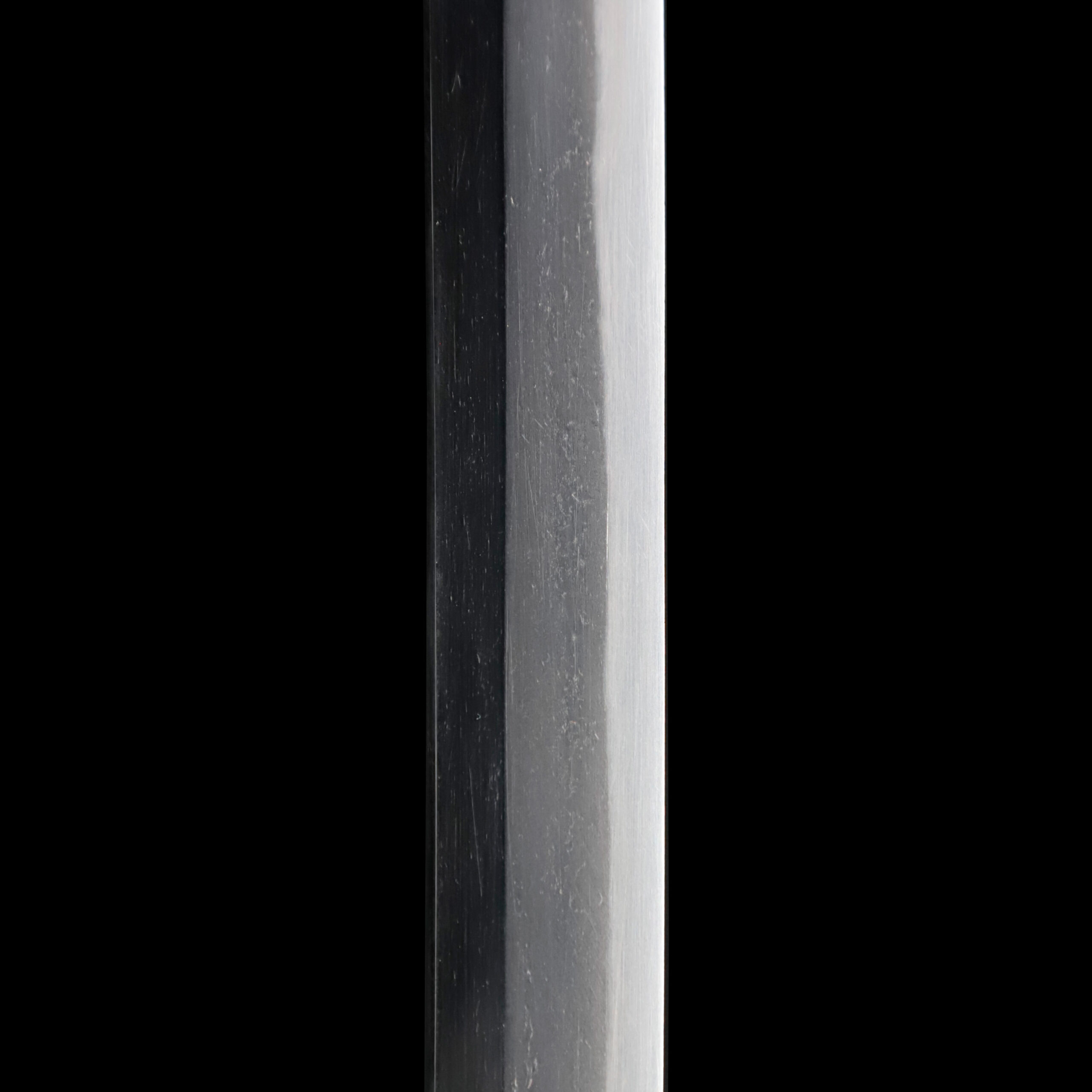
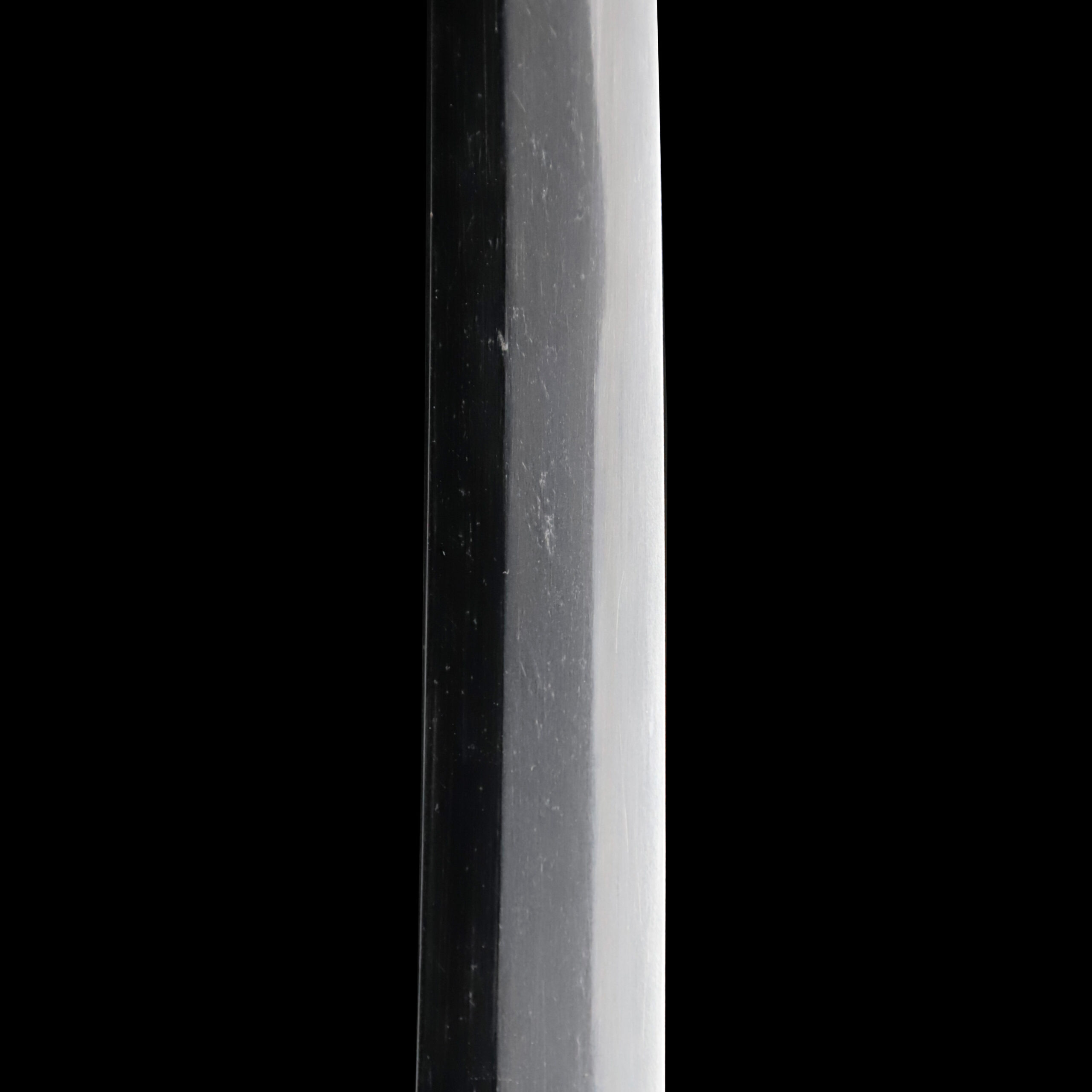
-Wakizashi
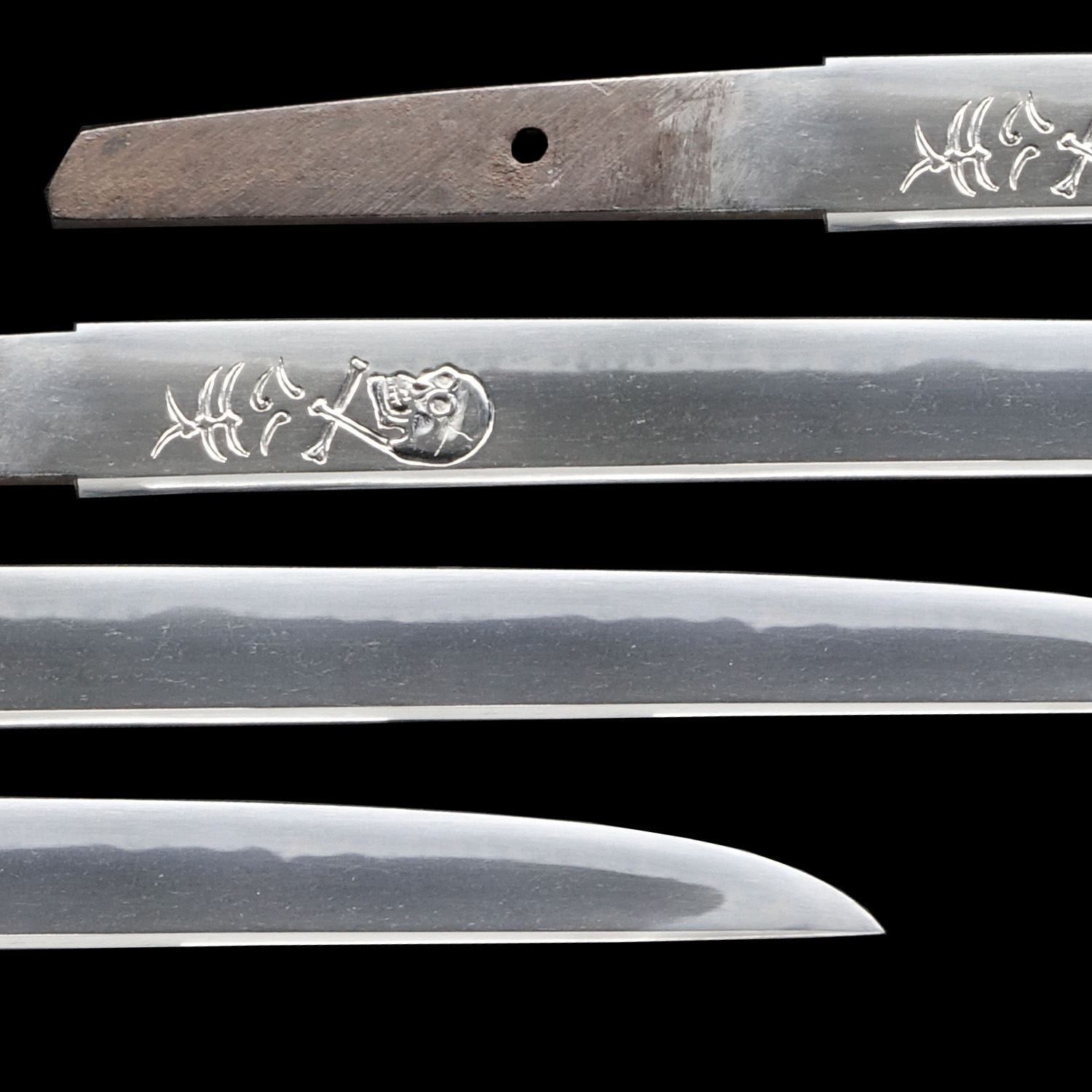
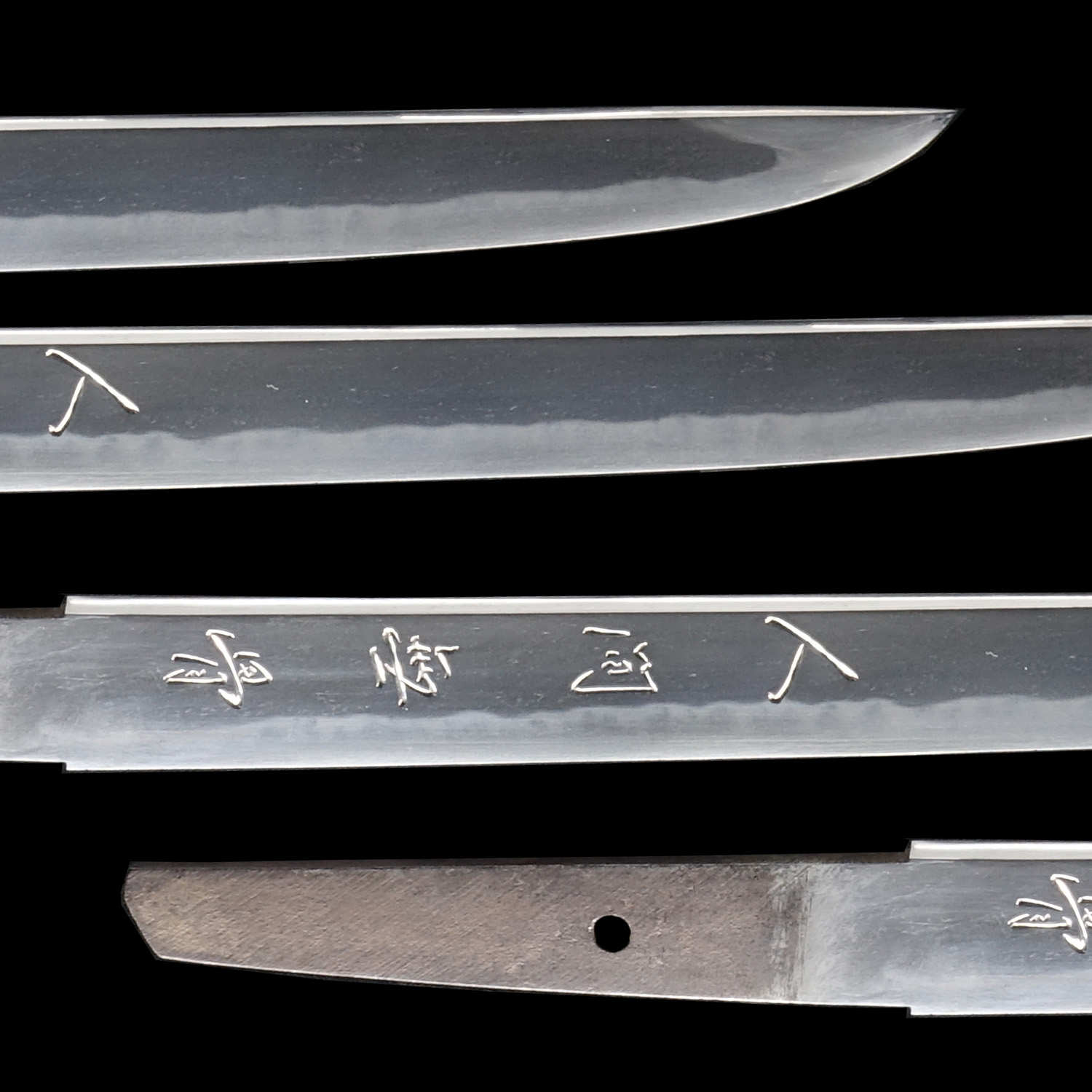
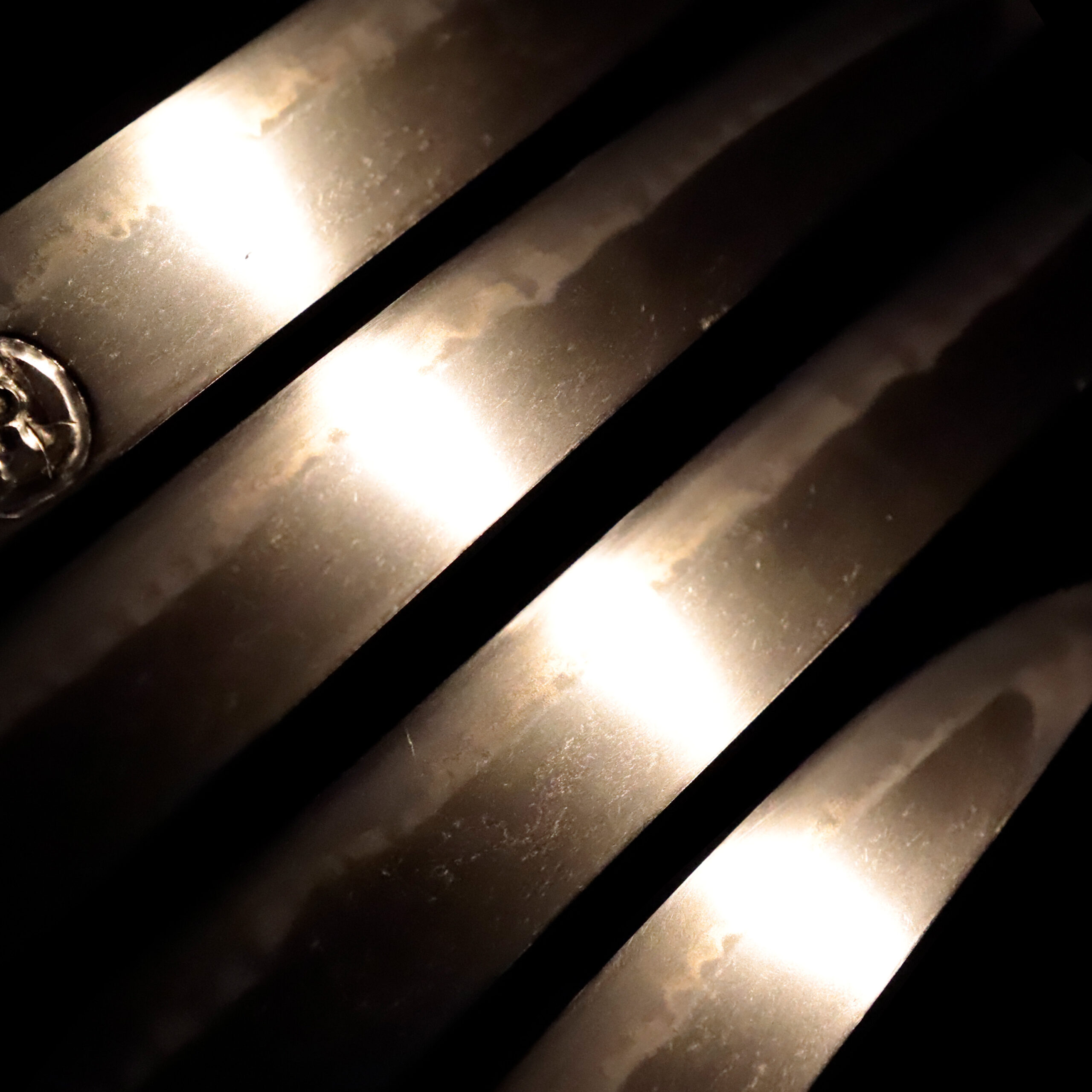
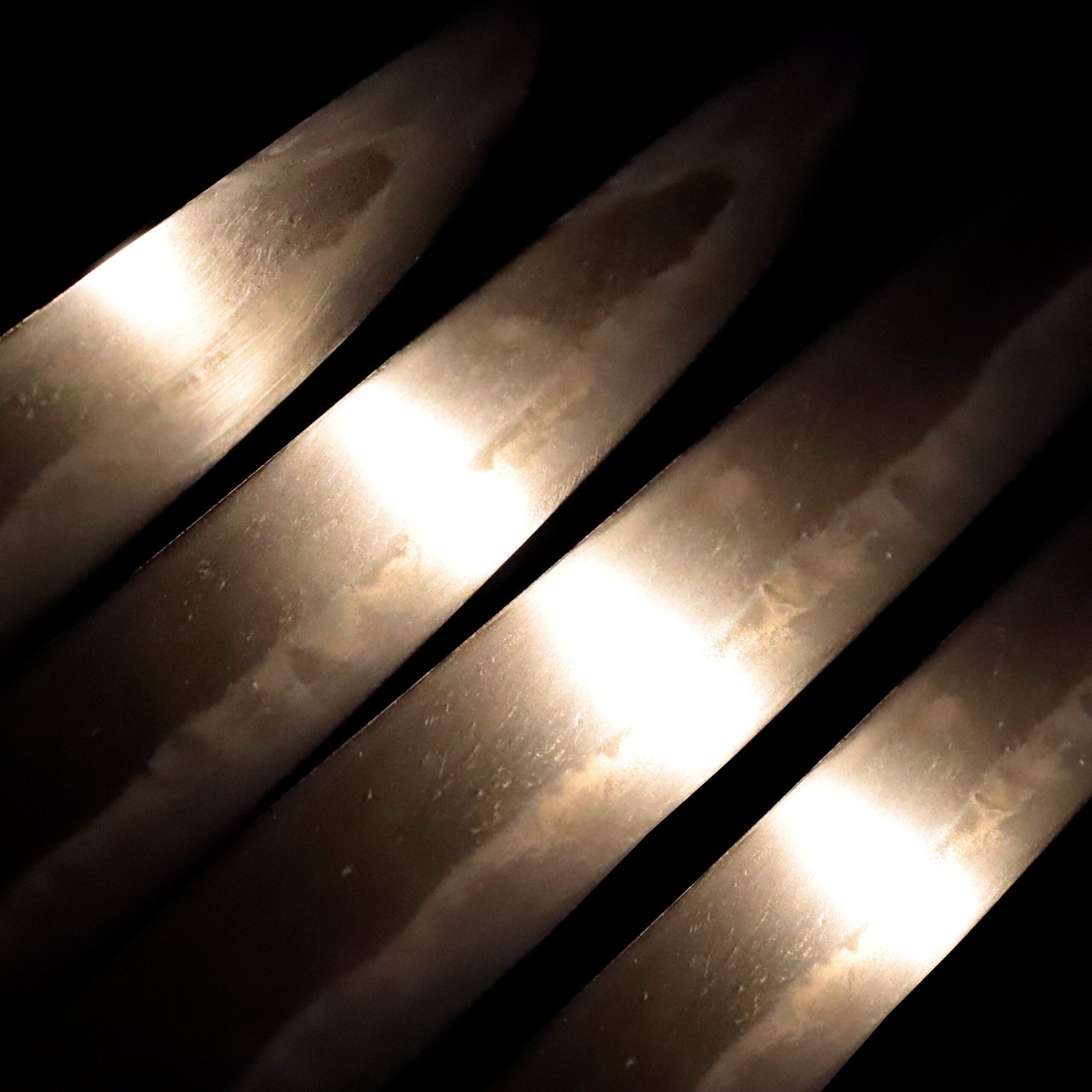
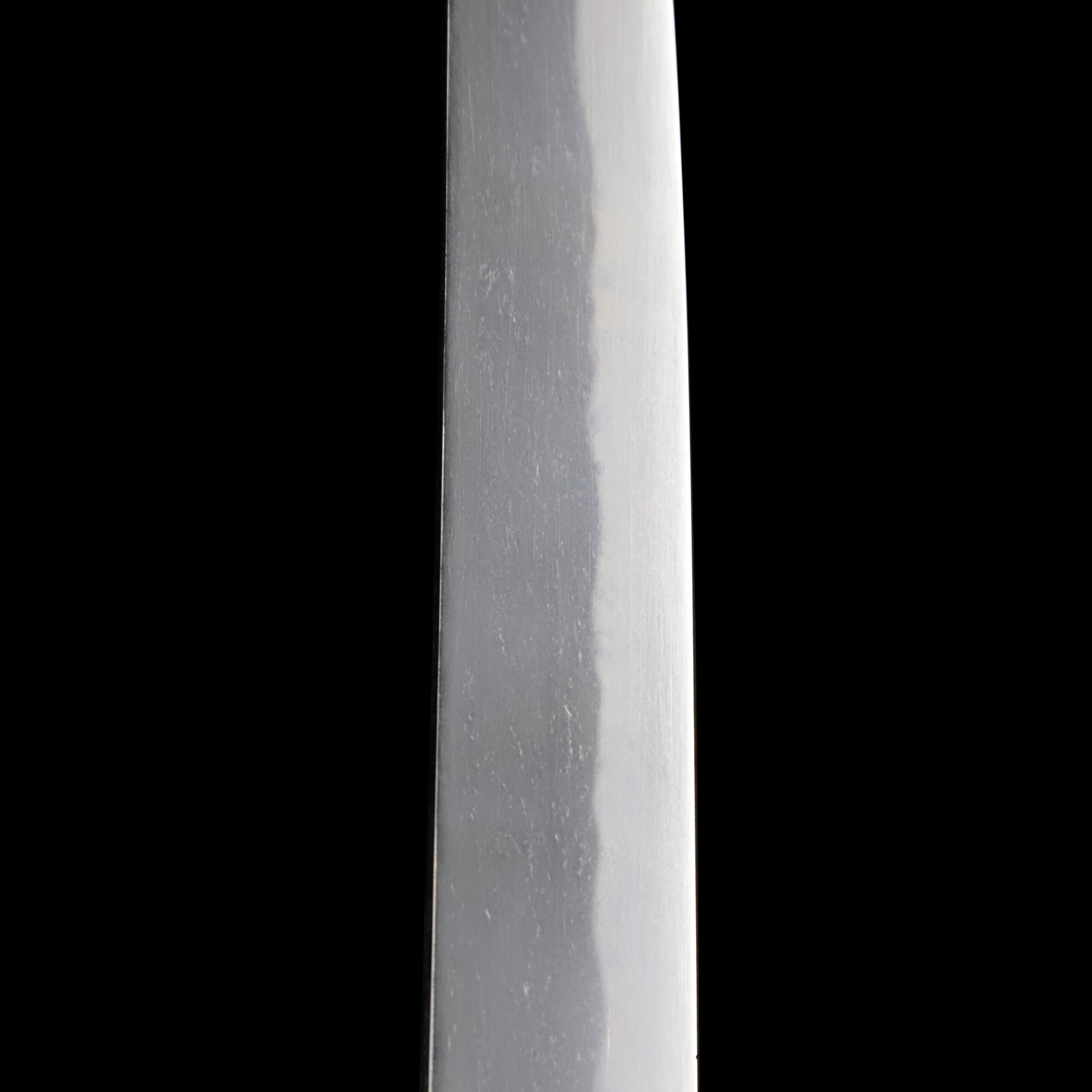
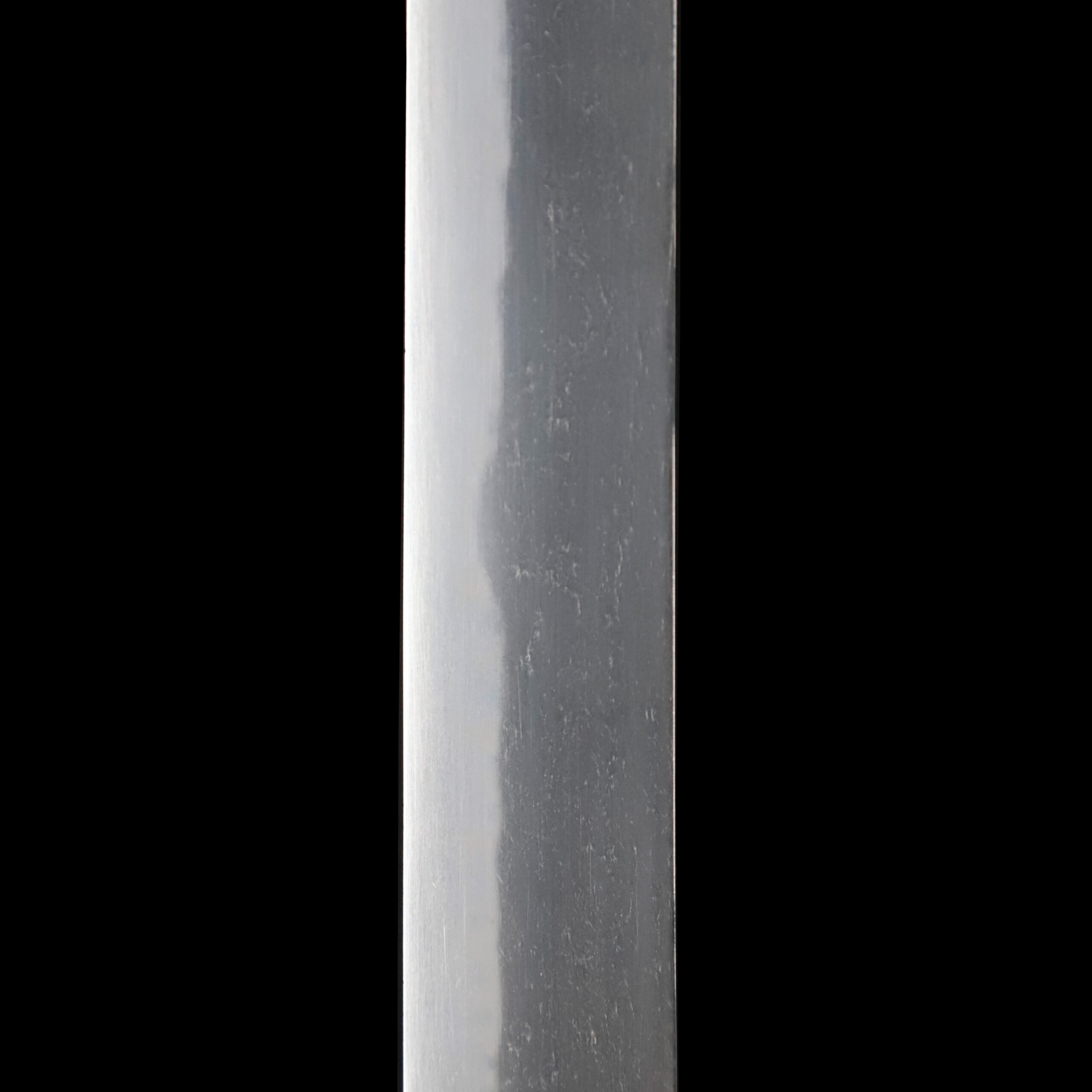
Nakago:Nakago is the tang of the Japanese sword.
Japanese swordsmiths left the black rust on the tang because it prevents red rust while the tang is in its handle. And the discoloration of the tang was created over time, and it is a great indicator for a Japanese sword specialist to estimate when the sword was forged.
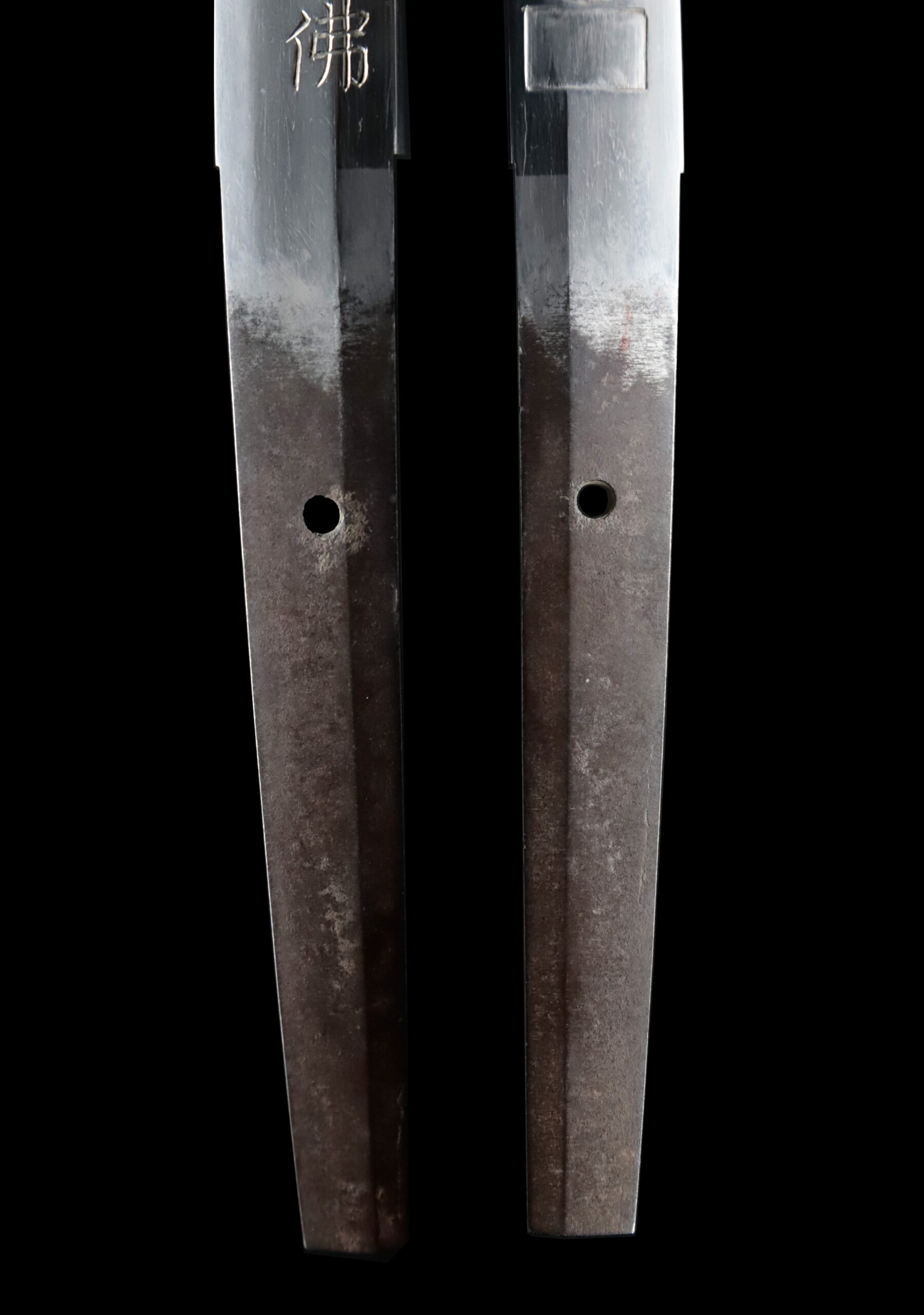
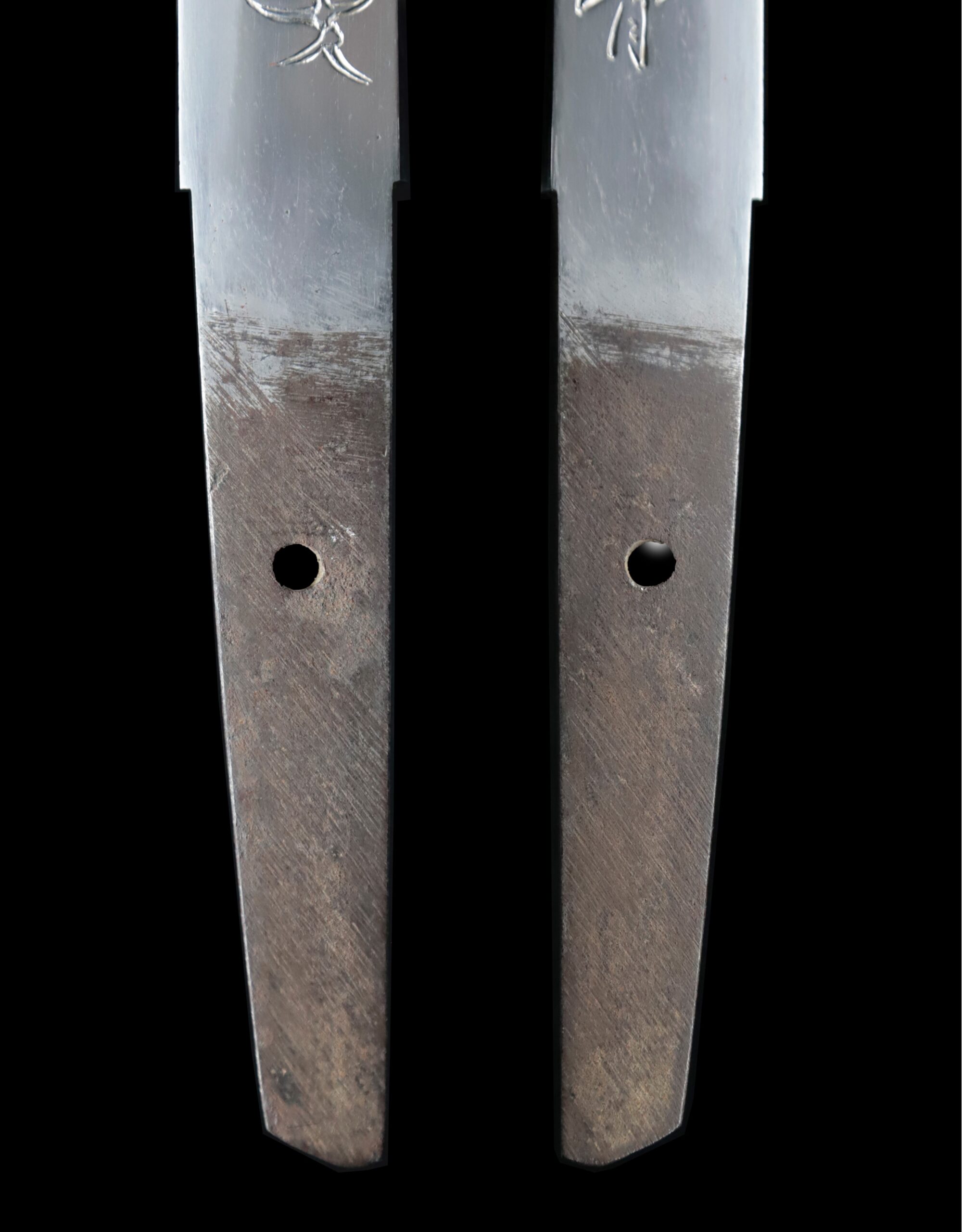
Koshirae: Koshirae is the mounting of the Japanese sword. There are several parts that consist of Koshirae such as Saya(Sabbard), Tsuka( Handle), Tsuba(Handguard).
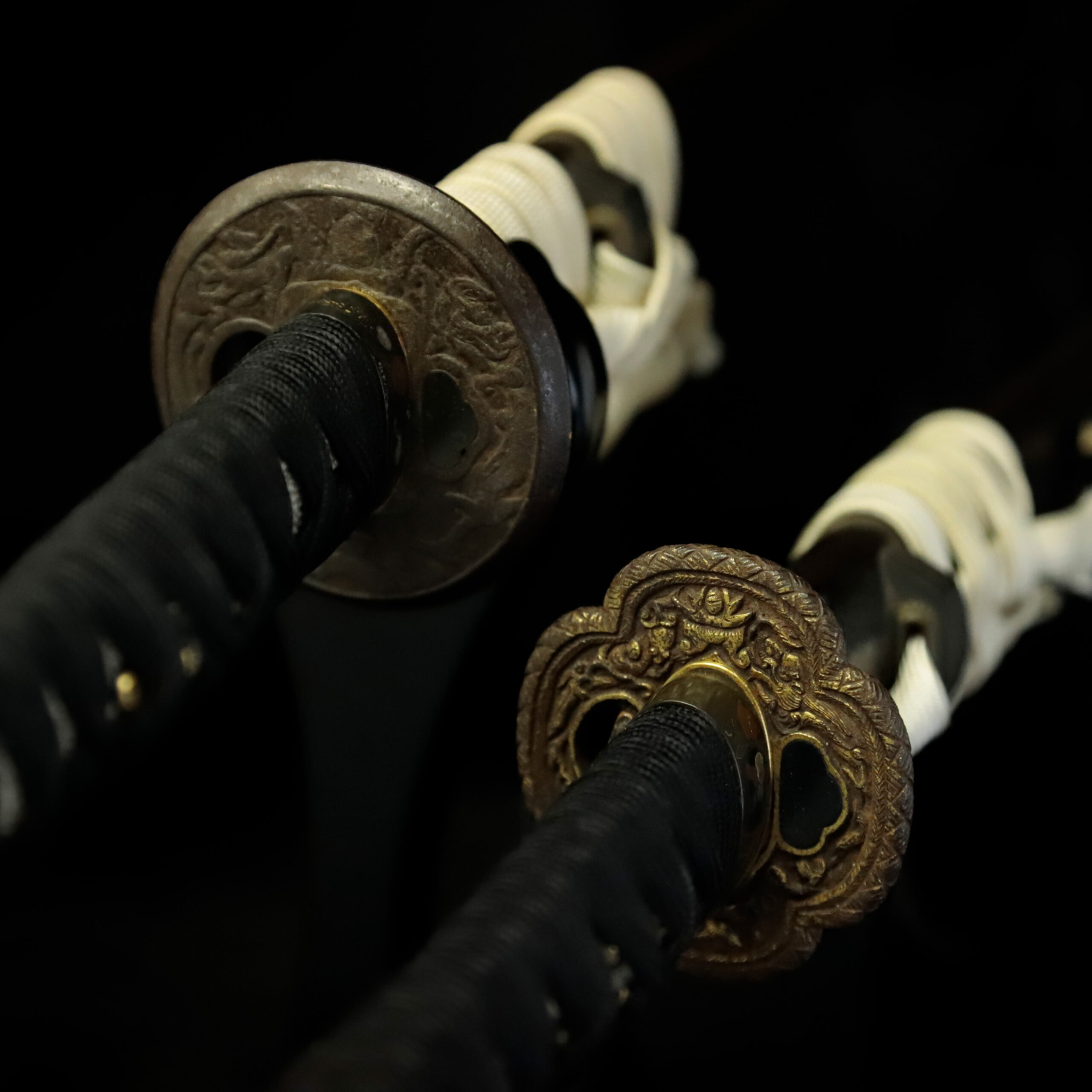
Fuchi-Kashira:A pair of matching sword fittings that cover the upper and bottom parts of its sword hilt.
The Katana Koshirae’s Fuchi Kashira has a different design on each part. Its Kashira is decorated with a flower design. We believe this plant is a peony. Silvery coloring is applied to its petals. Peony represents happiness, wealth, nobleness, and gorgeousness. This flower pattern has been treated as a kind of good-omen motif; people regarded it as a plentiful harvest sign, and some believed it symbolized eternal youth and longevity.
On the other hand, seashells are depicted on the Fuchi part. You could find multiple types of shellfish, including snails and bivalves. This work is decorative thanks to gold, silver, and perhaps copper-colored reddish-brown paint. Similar to the Kashira part, this metal fitting’s design is also related to natural motifs. A seashell is called the Kai (貝) in Japanese. Because of its pronunciation, a seashell has another meaning. There is a Japanese word Yarigai (やりがい, worthwhile). As a part of this word has the same accent as Kai (貝 is read Gai in some cases), Japanese people found this meaning. Also, since seashells are hard and combine only with their pair, people thought it represented a robust defense. Due to these meanings that inspire warriors who go to the battlefields, Samurai warriors might have loved this motif.
Now, please focus on Wakizashi’s Fuchi Kashira. Its Kashira part has a plain, simple look. However, the Fuchi part has a decorative appearance, and its design is similar to Katana Koshirae’s Fuchi. While the motifs depicted on each part are different, we estimate that these parts were possibly made by the same maker.
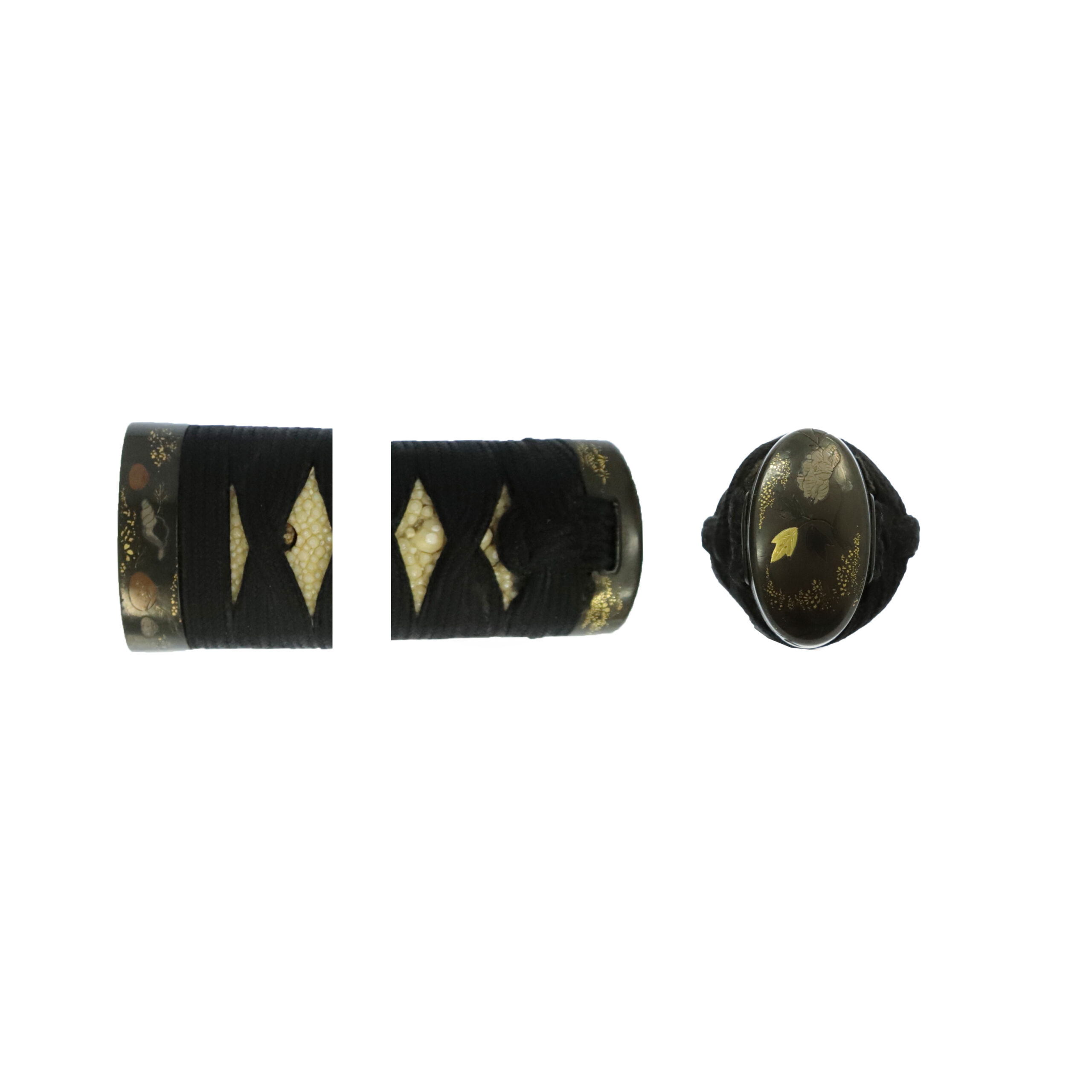
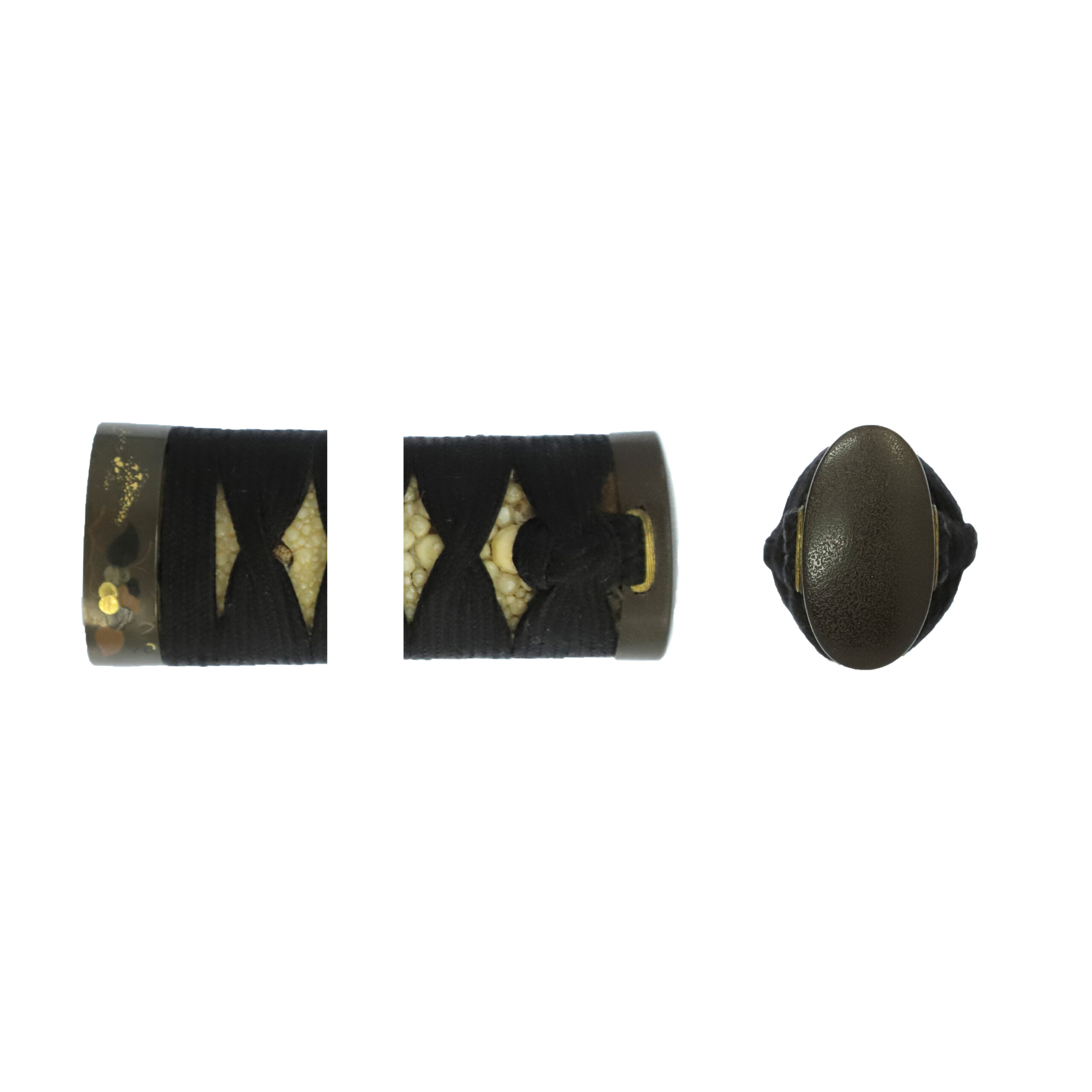
Tsuka and Menuki:Tsuka is the handle of the Japanese sword and Menuki is its decoration.
Since we cannot see the entire shape of each Menuki, it is challenging to judge the exact motif. However, it seems both Katana and Wakizashi have the same designed Menukis. Judging from what we could see through the gaps of the Tsukamaki threads, a plant is designed here. We assume this plant is a chrysanthemum based on the shape of the leaves and the shape of what looks probably a flower. Chrysanthemums symbolize fall, and people have greatly appreciated it since ancient times. As its petals form radially, a chrysanthemum has been likened to the sun. That is why this flower pattern is treated as the symbol of perpetual youth and longevity or good health.
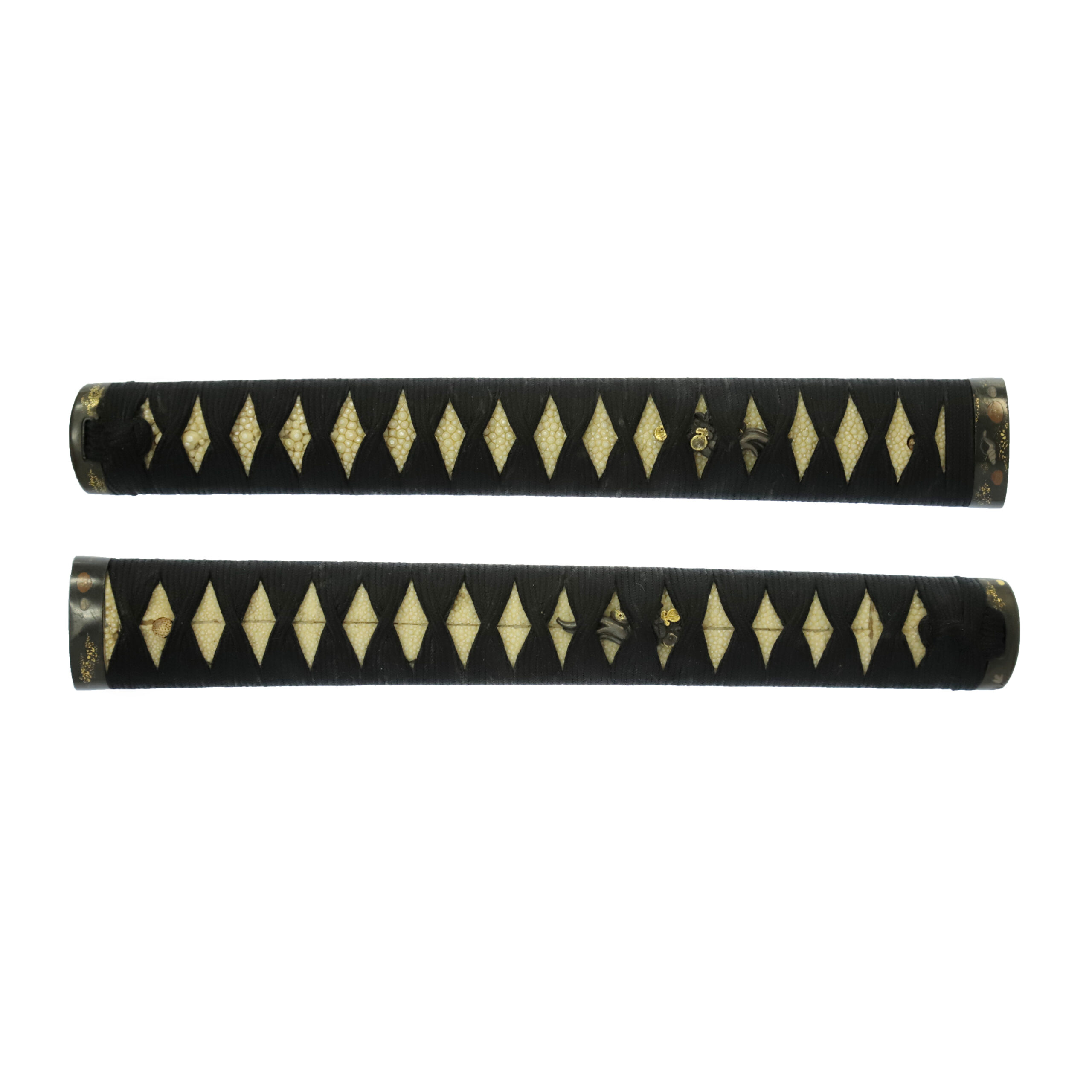
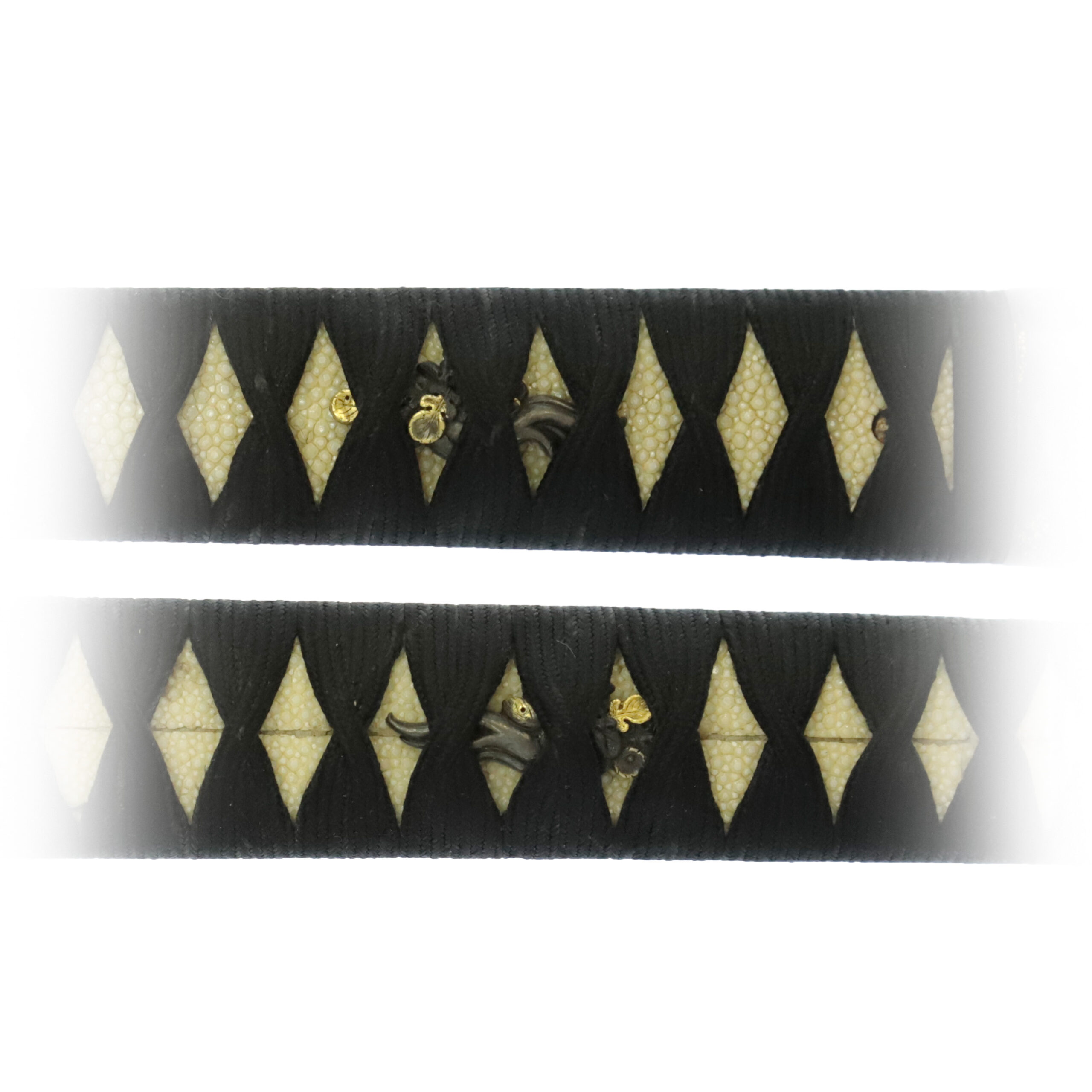
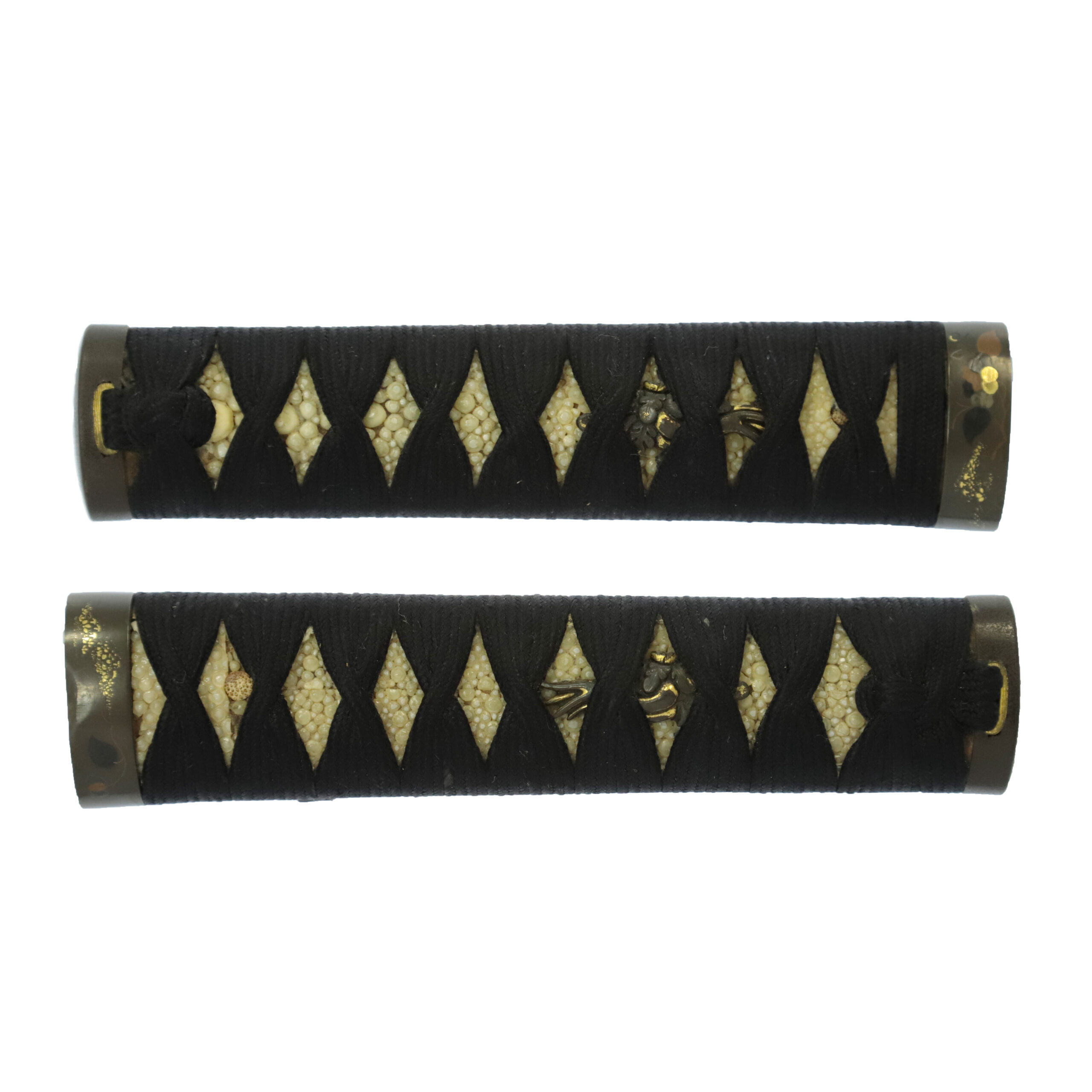
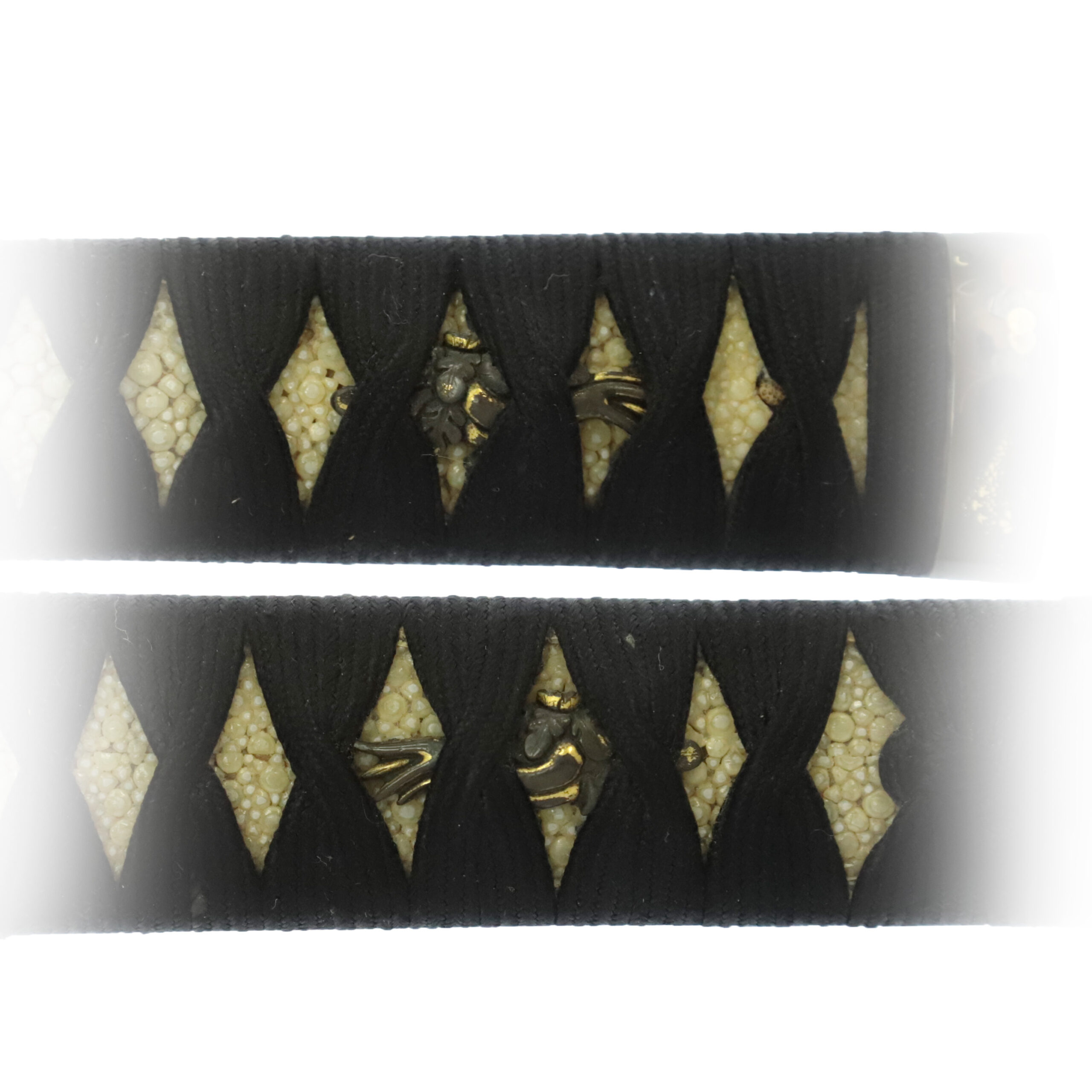
Tsuba and Habaki:Tsuba is the handguard for the Japanese Sword and Habaki is the equipment to make the blade not touch its scabbard inside. It prevents the blade from getting rusty and chipped.
This Katana Koshirae has an oval-shaped iron Tsuba. Its surface has become worn, and the design is uneasy to make out due to aging. This Tsuba depicts a plant pattern, or dragons, in simplified figures. The Wakizashi Koshirae’s Tsuba has a clearer design than this work. The Wakizashi’s Tsuba has a Yotsu-Mokkou shape, and you could find a dragon on its front side. The dragon looked up and opened its mouth. In front of the dragon’s line of sight is a ball-like object on a pedestal, which we believe is a jewel. Based on our experience, there are a variety of dragon-designed sword mountings. Initially, dragons were imaginary creatures found in ancient foreign traditions and myths. Furthermore, it is regarded as a symbolic beast of auspicious signs. Its body is likened to nine animals: antlers are deer, the head is a camel, eyes are demons, the neck is a snake, the belly is the Mizuchi (蛟, a mythical animal in Japan that is similar to a snake and has a horn and four legs), scales are fish, claws are falcons, palms are tigers, and ears are cows. It was thought that the dragon would reign at the top of all animals because of its odd-looking appearance. We imagine many Samurai favored this sacred beast motif due to its dignified appearance and auspiciousness.
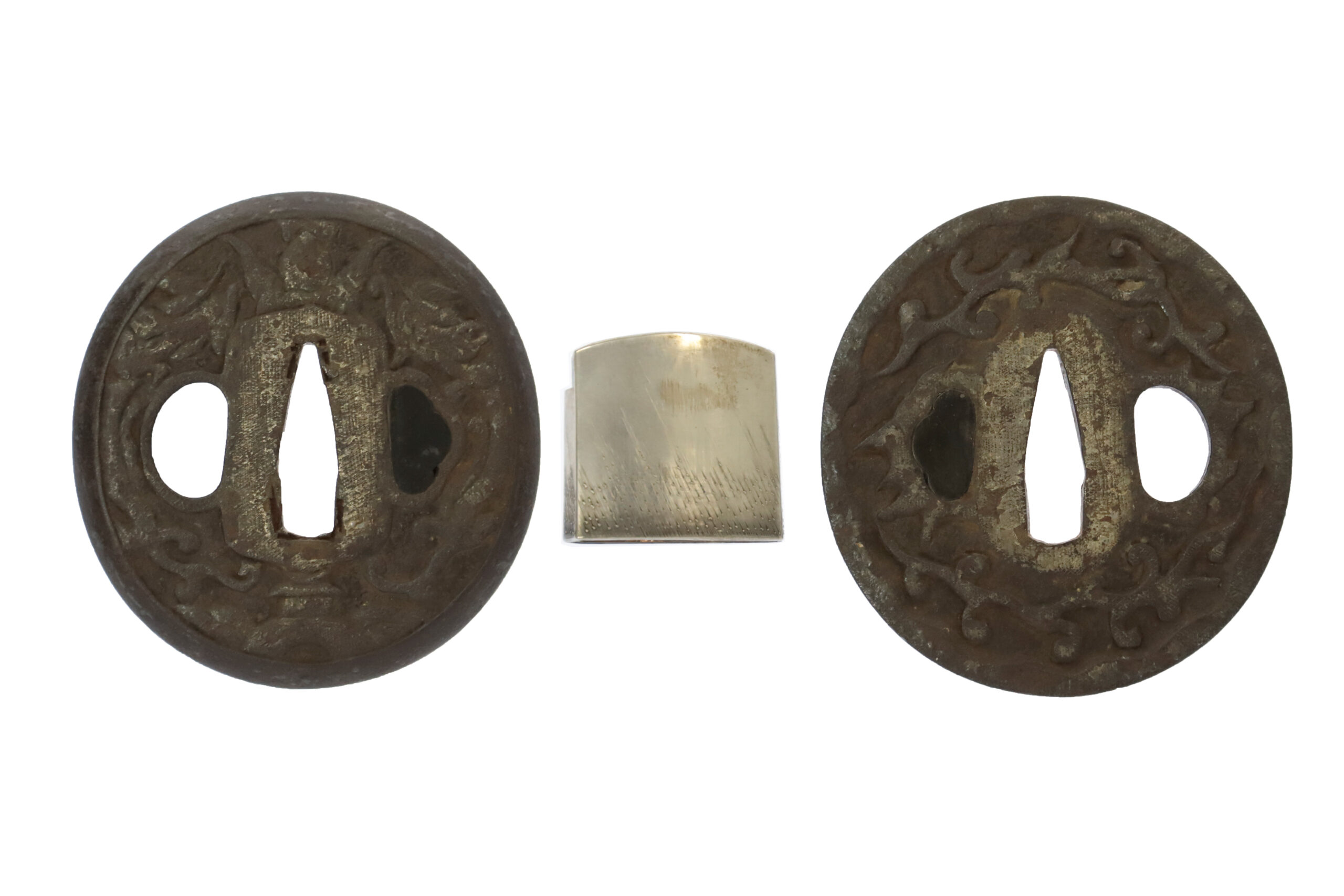
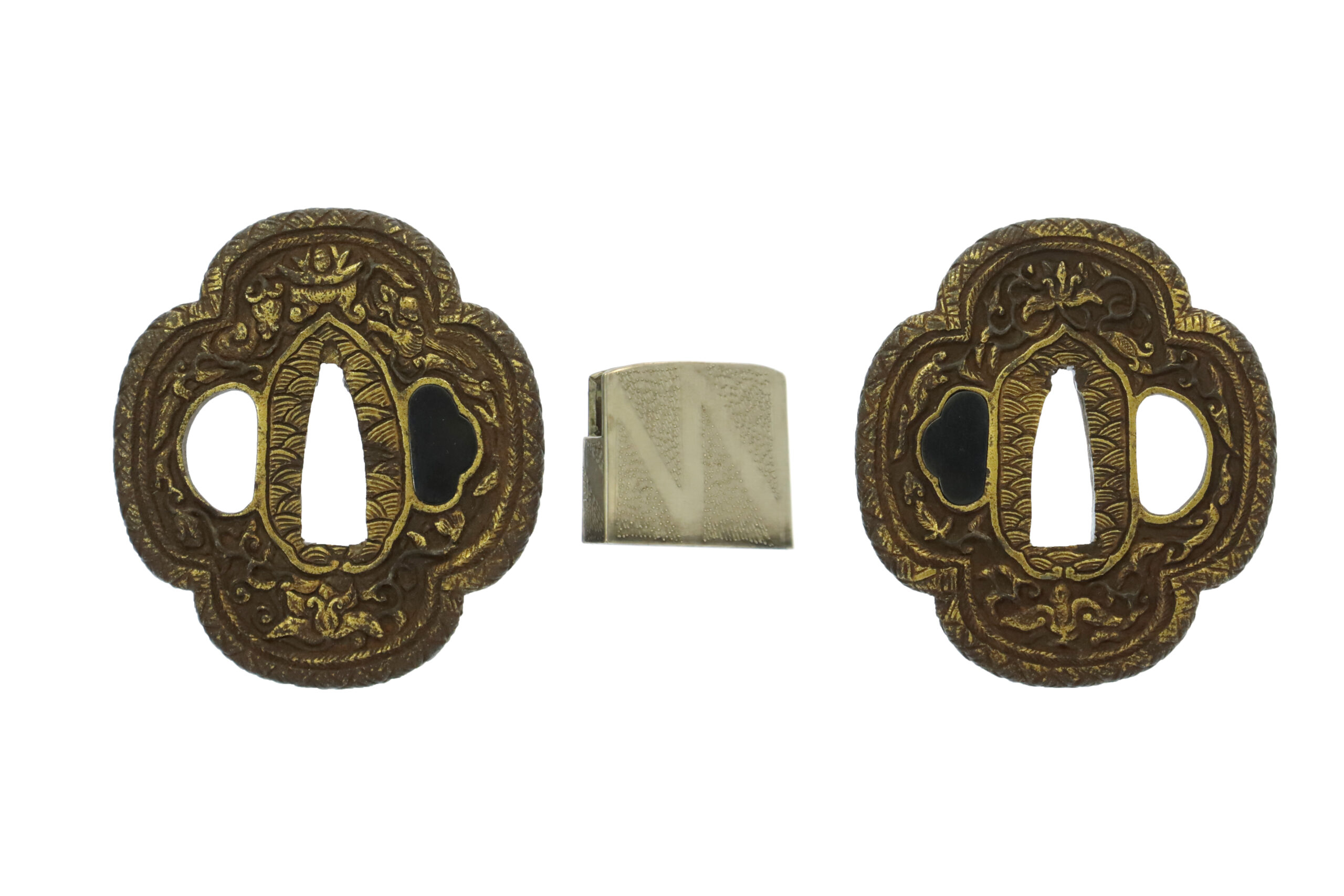
Kozuka:Kozuka is a small knife stored in Kozuka Hitsu(groove of the sheath of the Japanese sword).
A Kogatana (小刀, small knife) is stored in the Kozuka. The surface of this Kozuka is decorated with the Nanako-Ji (魚子地) technique. This process makes a uniform minimal protrusions pattern by hitting the Nanako-Ji Tagane (魚子地鏨, a chisel for this technique) on a metal surface. This decorative technique is often seen on sword mountings. Also, the edge of Kozuka is colored with golden paint. Although most of this coloring has already faded due to aging, we could imagine it was initially decorated with this bright golden paint.
About the design, the Ume (梅, Japanese apricot blossom) is depicted on this work. Japanese apricot blossoms begin to bloom in winter when snow still covers their trees; people thought this flower tells the arrival of spring. The same as cherry blossom, it has been appreciated for a long time in Japan. People enjoy its adorable petal shape and scent and gracefully branched tree, and they have composed many poems about it. As it comes out in the cold season, it symbolizes the power of perseverance and vitality.
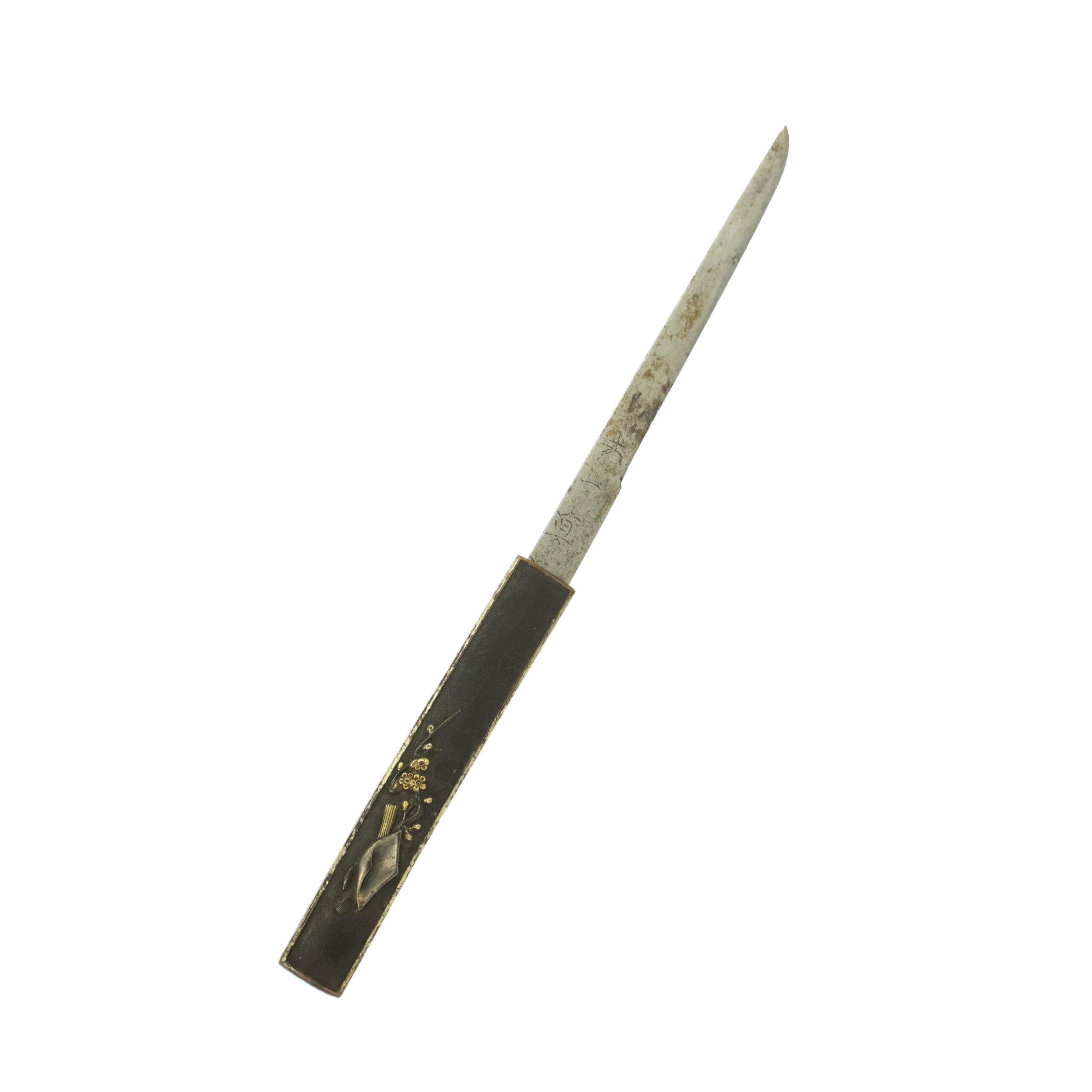
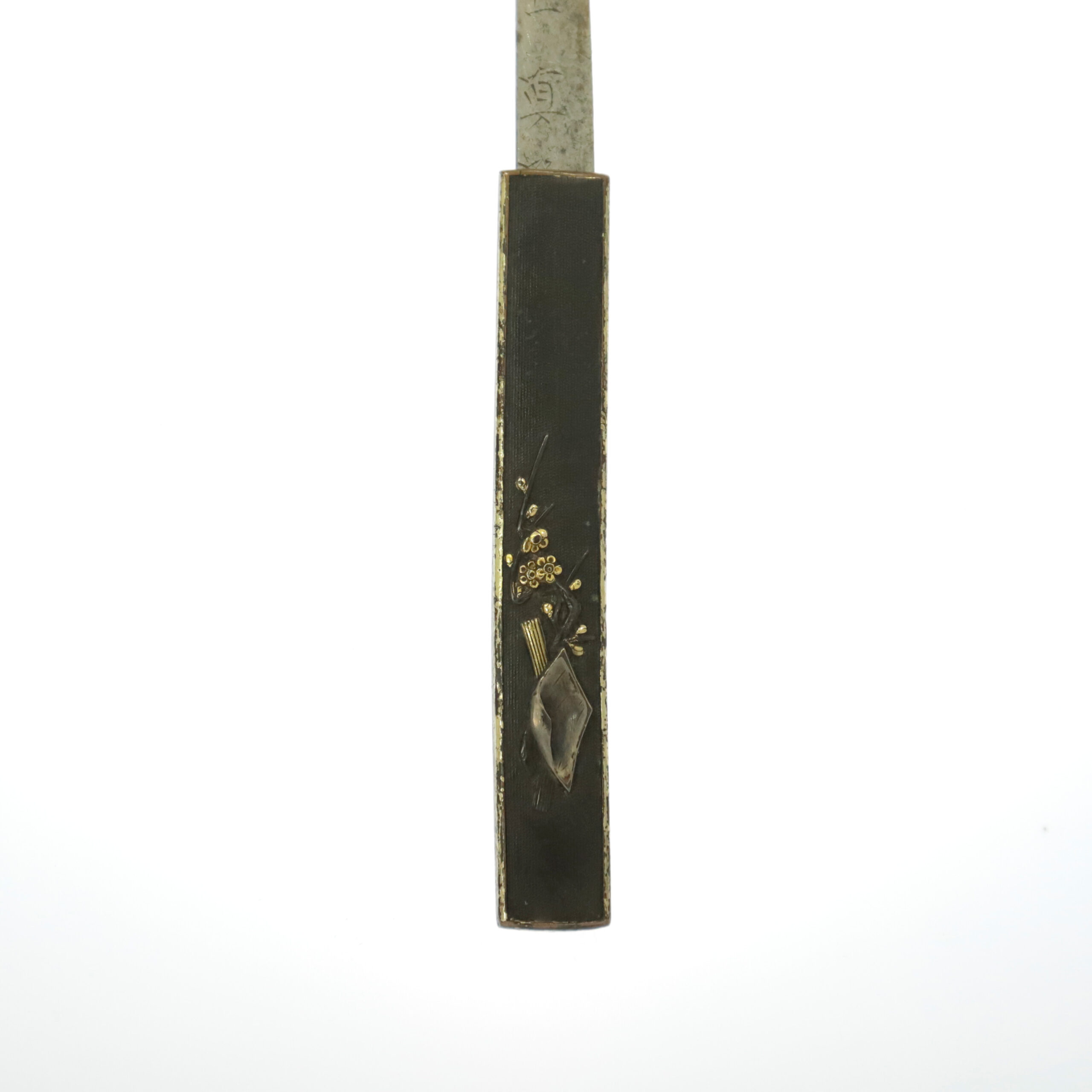
Saya: Saya is the scabbard for the Japanese sword.
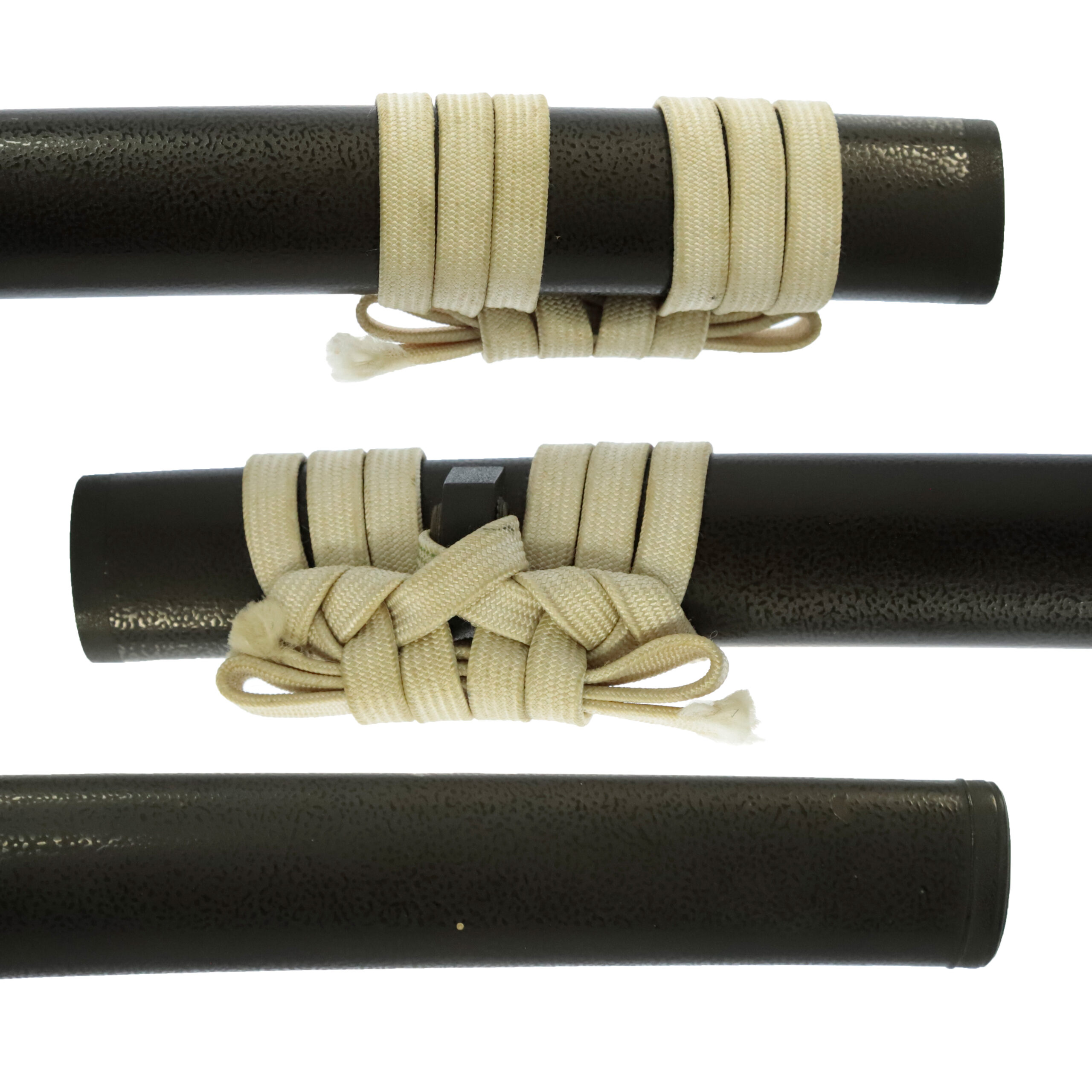
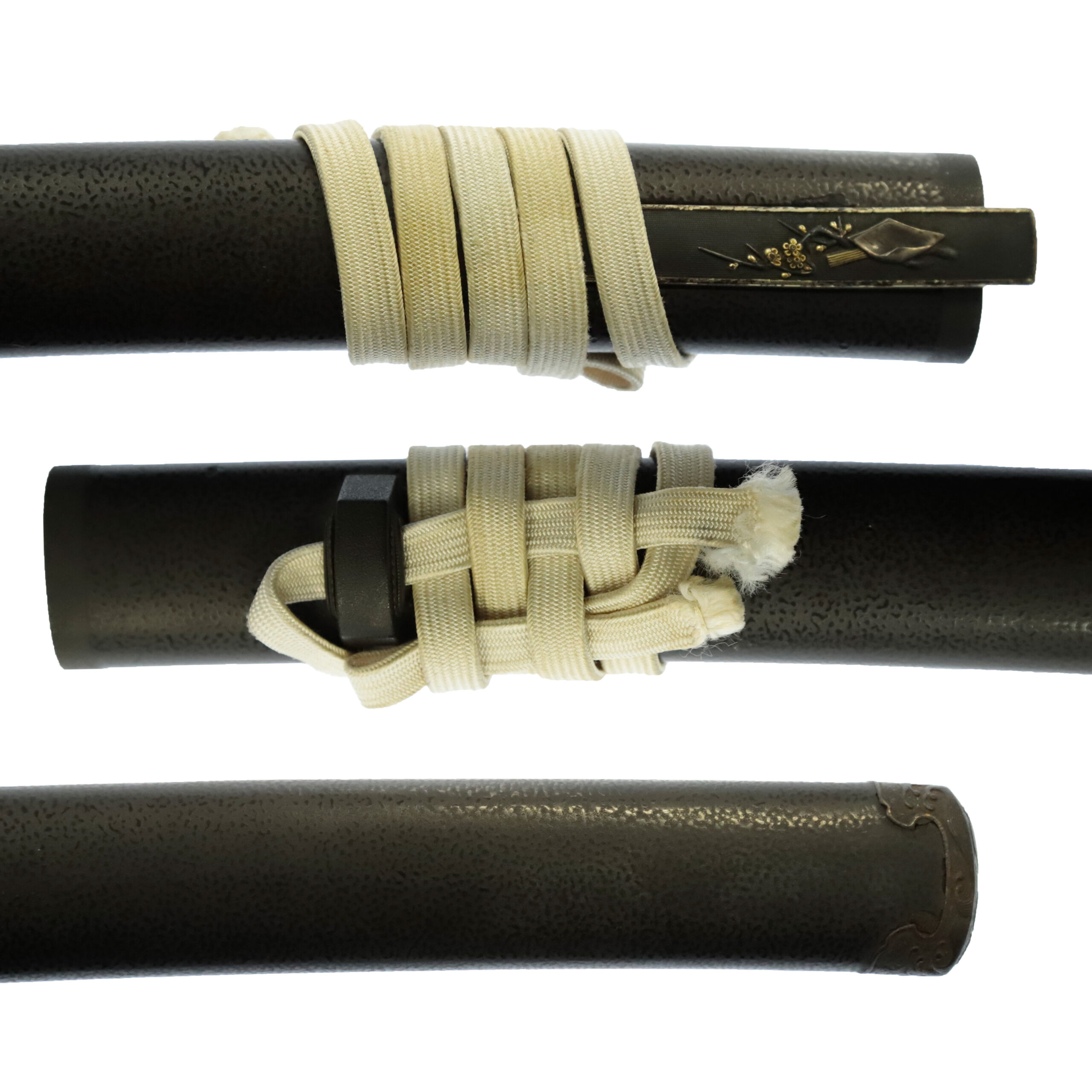
Authentication Paper:NTHK-NPO Kanteisho Certificate for Katana, Wakizashi
NTHK, also known as NPO Nihon Touken Hozon Kai, is the oldest organization for sword authentication of Japanese swords in modern times. It was established in 1910 during the post-Samurai era. They authenticated the Katana and Wakizashi blades on June 18th in the 5th year of Reiwa (2023). The purchaser will receive these original certificates as well. We can also translate what is written into English and make a PDF file for your record if you request.
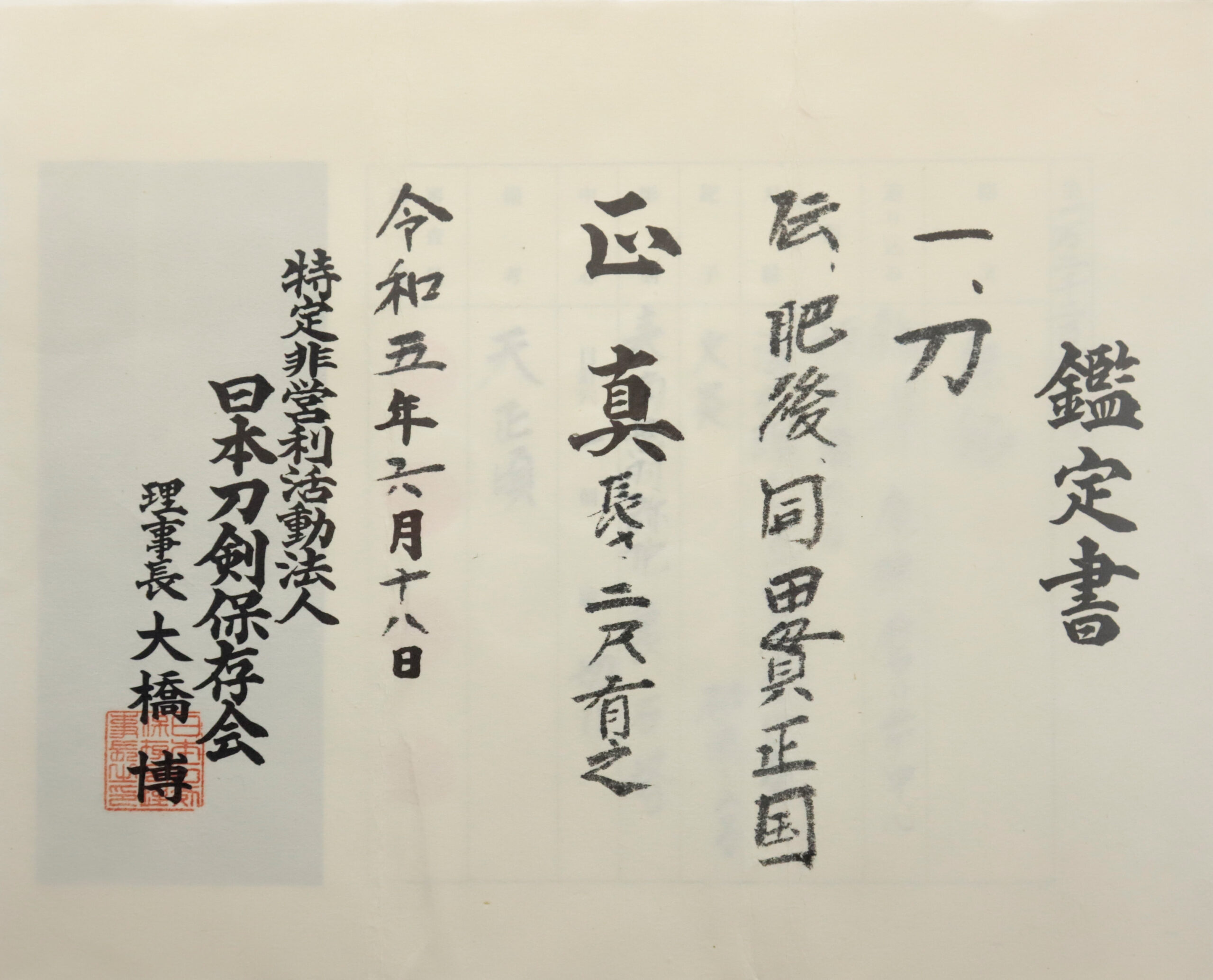
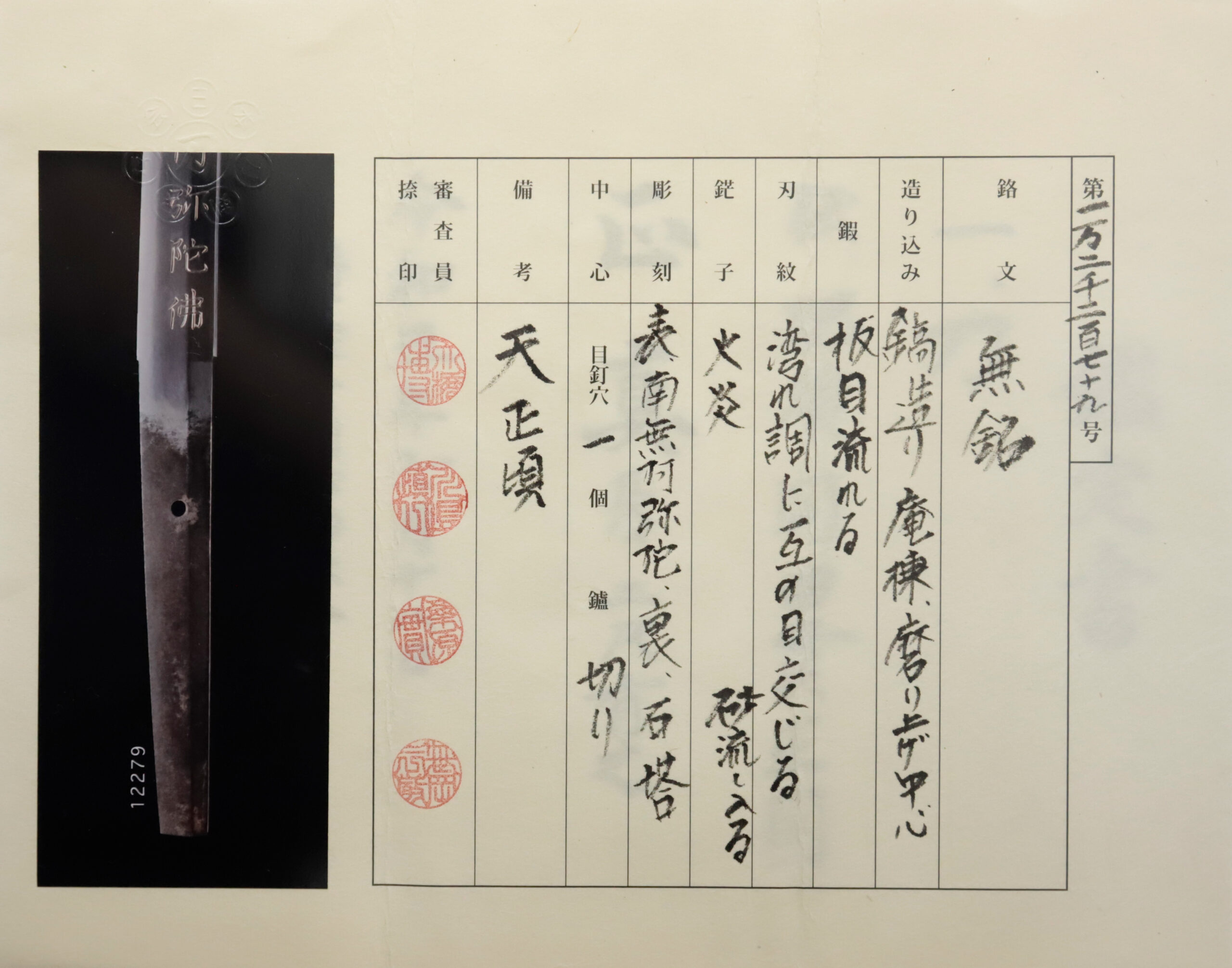
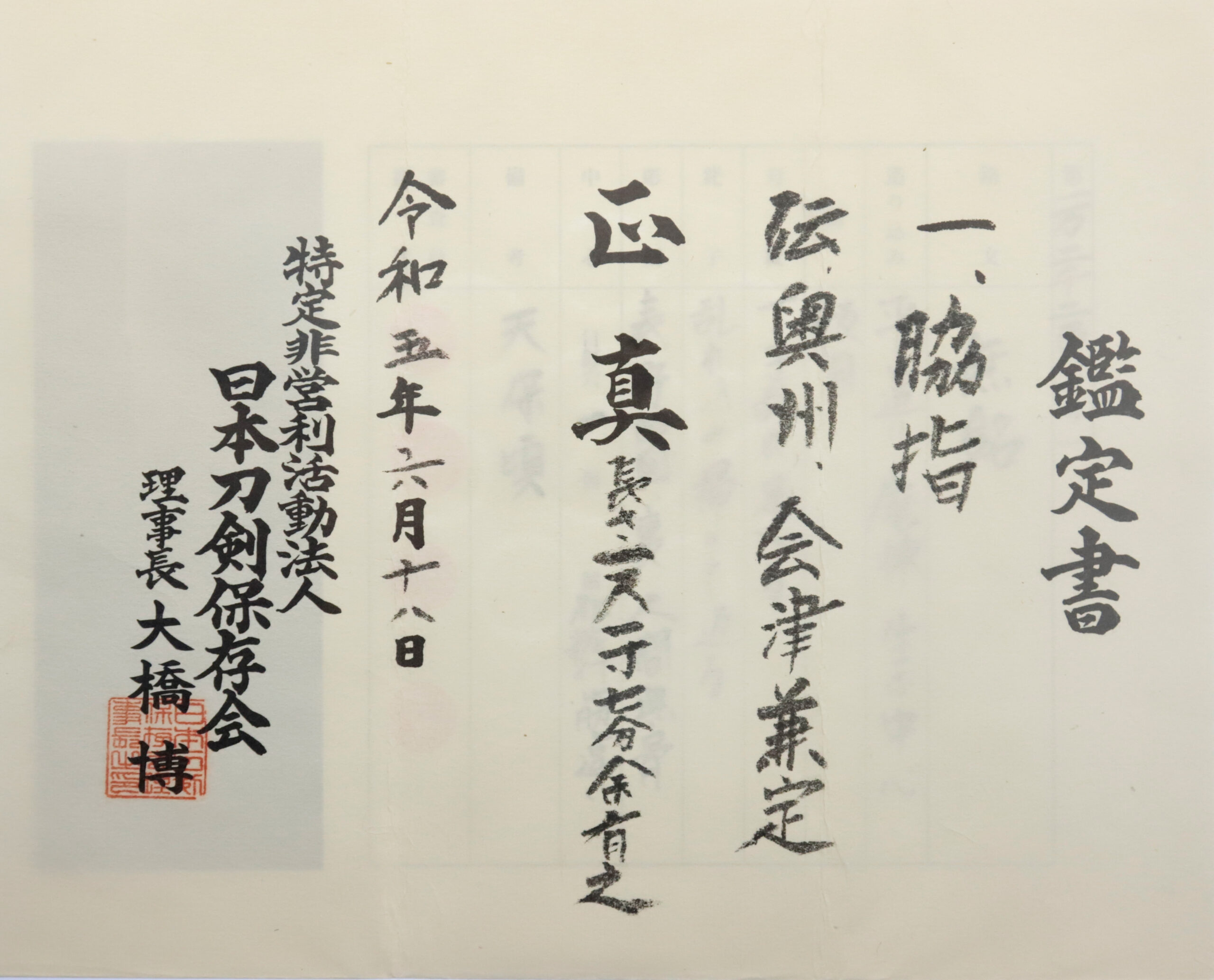
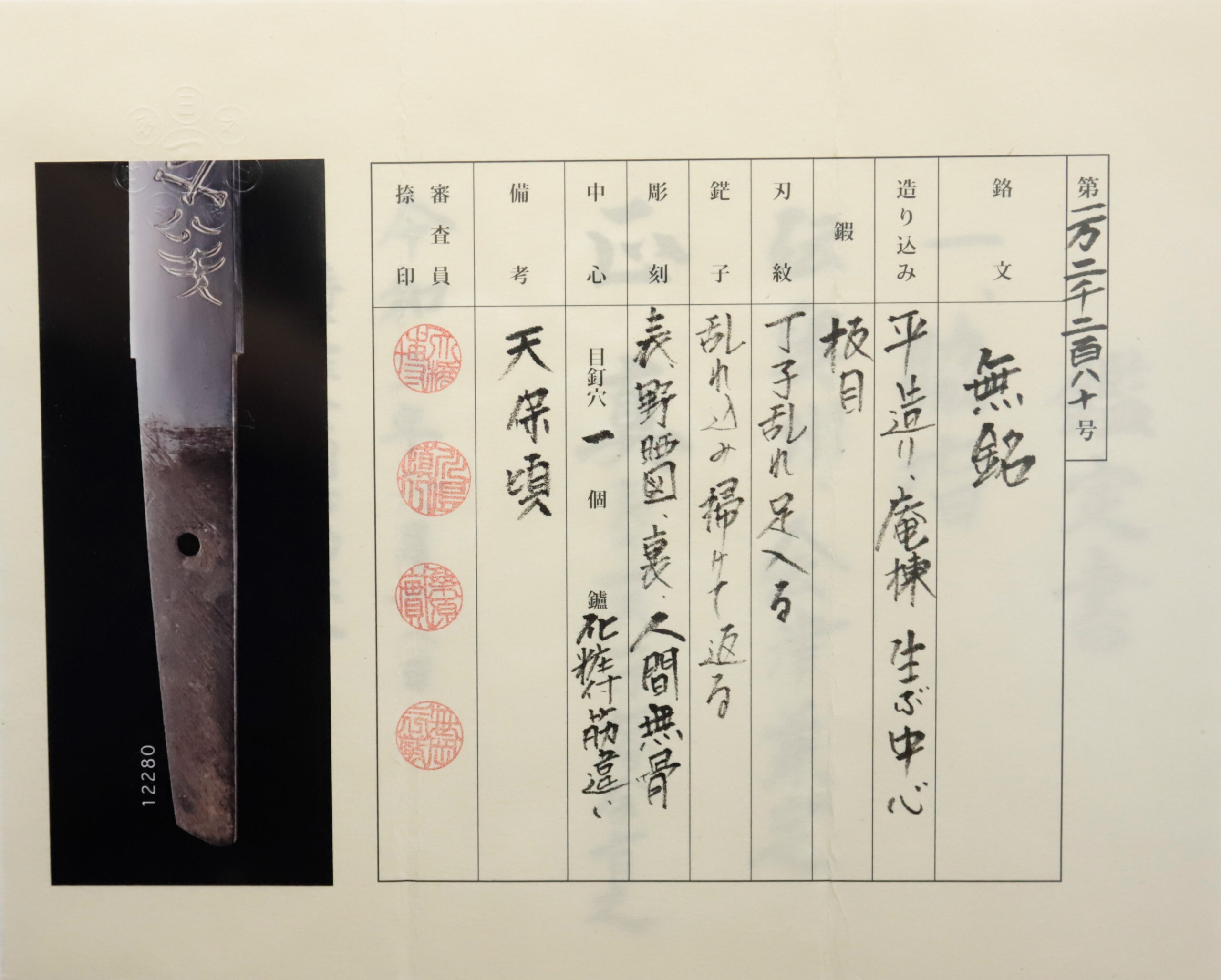
Registration Number : Tokyo 326559-326560
The Board of Education in Tokyo prefecture issued a registration paper for the Katana and Wakizashi blade. It is called Jyu Token Rui Torokusho(銃刀剣類登録証). Bunkacho(The Agency for Cultural Affairs) acknowledges a Japanese sword with this paper as a work of art.
The sword needs to be traditionally hand-forged and made of Tamahagane carbon steel to be registered in the system. With this paper, its owner in Japan can legally own an authentic Japanese sword. Based on this registration number, we will apply for its export permit.
This paper will need to be returned to the board of education when the sword is being shipped abroad, but you can receive a copy of it. An English translation of this registration paper is available on request.
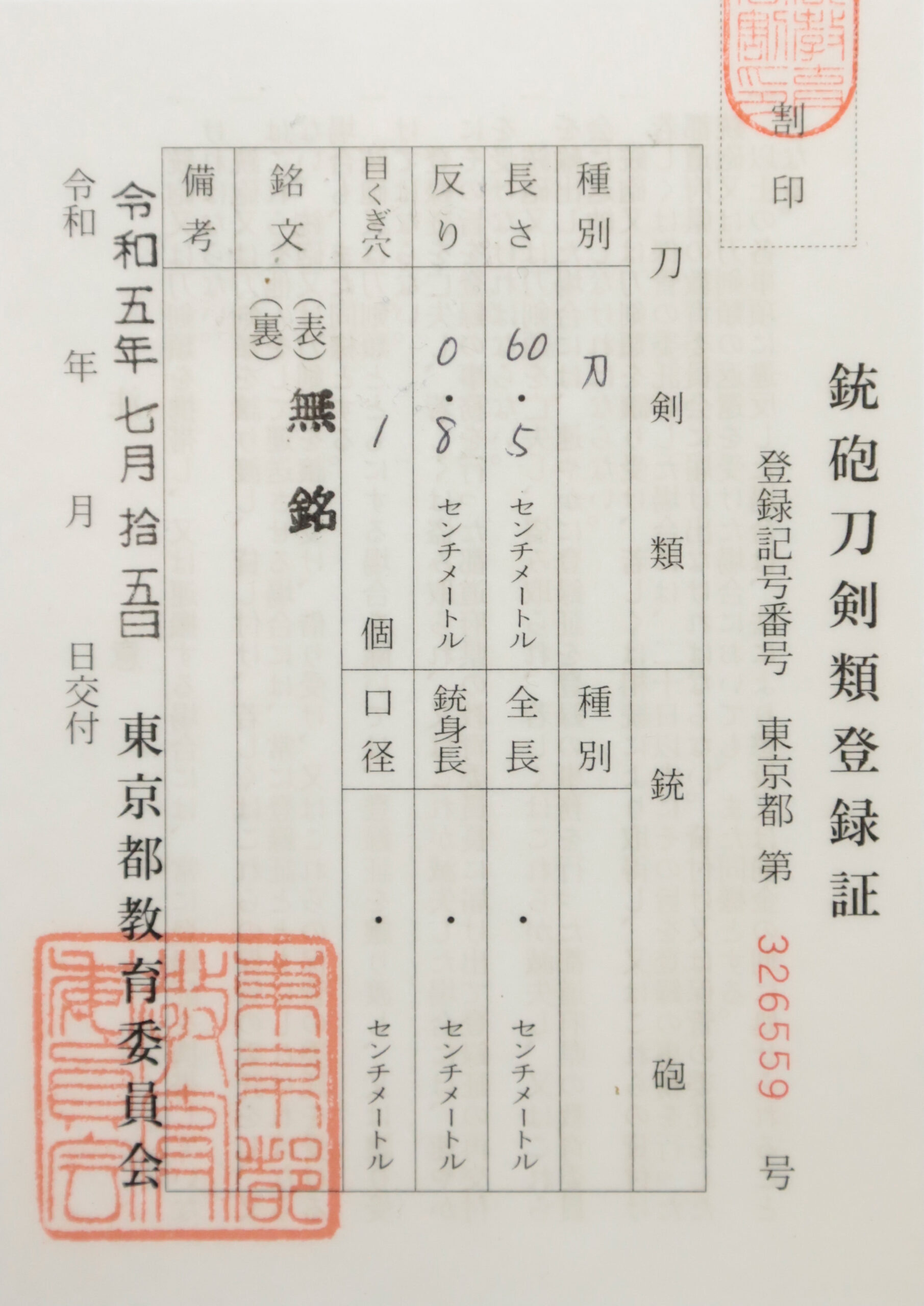

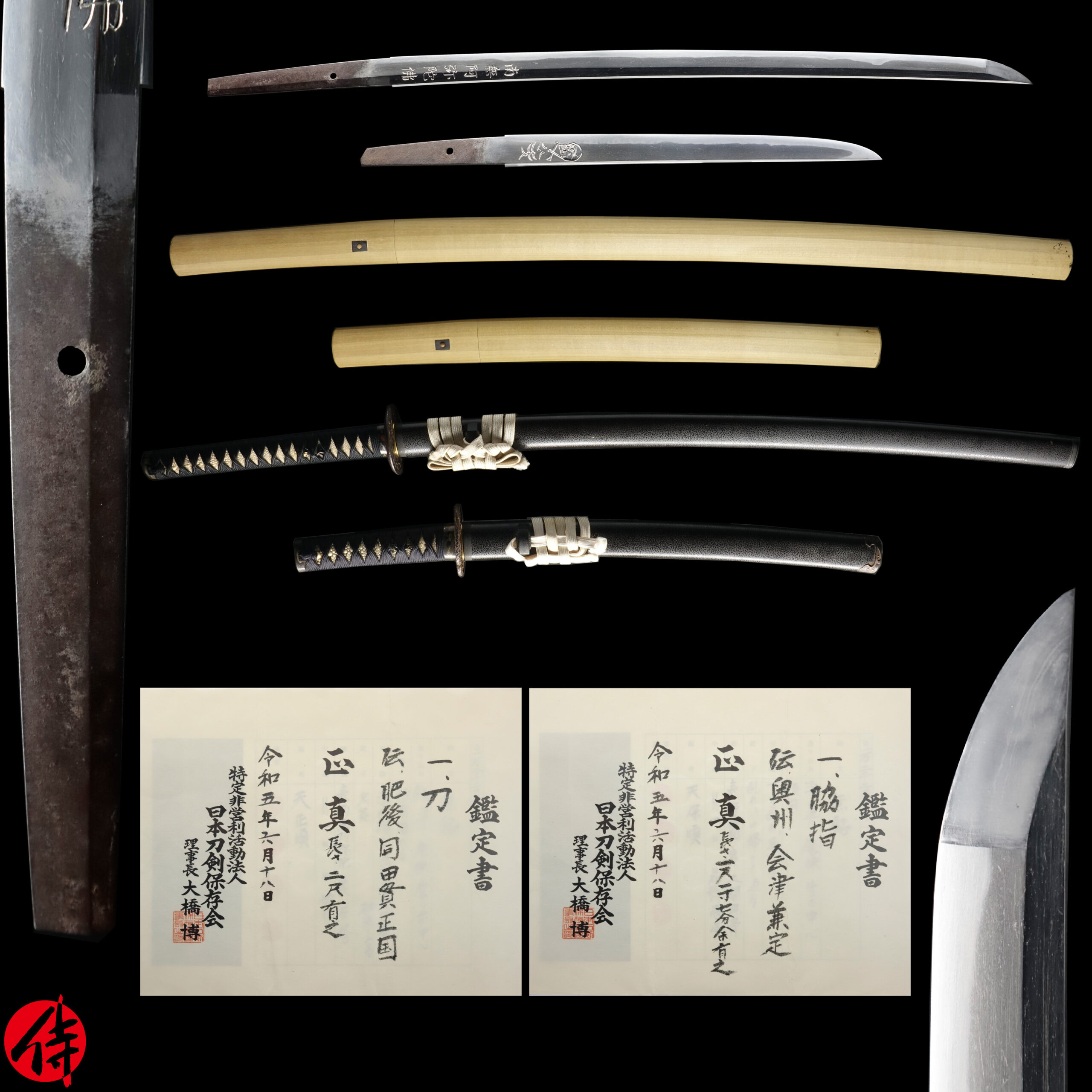
—————————————————————–
【About us】
Samurai Museum is located in Tokyo, Japan, exhibiting antique artifacts related to the Samurai history. Samurai Museum Shop is the place for those who are interested in Japanese culture and craftsmanship. We deal with antique Samurai swords/armor, traditional crafts made in Japan and so on.
【Japanese Sword& Export Process】
The Japanese swords we deal with are hand-forged edged swords made in Japan. It was made from the traditional carbon steel called TAMAHAGANE(玉鋼). Samurai Museum is familiar with the proper legal procedure for an antique/ authentic Japanese sword to be exported from Japan. We have sent more than 400 Japanese swords for the past three years (~2022) to amazing owners who appreciate its historical value.
Each Japanese sword is registered under the Agency for Cultural Affairs and the Board of Education in Japan. They issue a registration paper for each Japanese sword for its owner in Japan to legally possess it. The Japanese sword with its registration paper means it was traditionally hand-forged in Japan.
To legally export the sword from Japan to other countries, we will have to apply for its permit to the Agency for Cultural Affairs(Bunkacho) and return the original registration paper to the Board of Education. It normally takes around 2-4 weeks to receive this permit after submitting required documents. And we would like you to expect at least 1-1.5 months for your order to arrive at your given address after you ordered. For more detailed info, please click here.
It is allowed for residents in Japan to own authentic Japanese swords without a special license as long as they come with registration papers. Please feel free to contact us if you are a resident of Japan, whether temporarily or permanently. We will also assist you when you leave Japan and need to obtain the export permit.
【Payment Method】
We accept payment through Stripe (Credit card), PayPal, Apple Pay or ChromePay, all of which are secure payment methods. Also, you don’t need to make an account on Stripe for the checkout. If you prefer other payment method, please contact us. After confirming your payment, we will apply for an export permit. You may either pay in JPY, USD, AUD, CAD,EUR or GBP. The price is set in Japanese Yen. Prices in other currencies are automatically calculated based on the latest exchange rate.

* If the amount is above 1 million JPY, Stripe or wire transfer will be the only options for payment.
【Shipping】
We have shipped authentic Japanese swords to the USA, UK, Canada, Mexico, Germany, France, Hong Kong and Australia. If you don’t live in these countries and like to order, please contact us first before making a purchase. We offer Free International Shipping as long as we can send antique Japanese swords by either EMS or FedEx(Canada).
We normally ship by EMS(Express Mail Service) provided by Japan Post. When we receive an order from the Canada we will use FedEx instead as EMS temporarily stops shipping from Japan to those countries due to COVID-19.
We will send you a tracking number for your order as soon as we hand it to the post office/FedEx. We will put 100 % insurance on the shipping document without any extra charge. Based on the total amount, there might be a duty tax or other fee for you to pay, depending on the countries. We use package cushioning to protect the item and put it in a PVC pipe, which is one of the most secure packages because of its durability.
It will normally takes 5-14 days for the item to arrive at your given address after we dispatch it. Time of delivery is estimated as accurately as possible by the carrier but does not take into account any delays beyond our control such as by inclement weather, post office holiday seasons.
* If you live in Australia and like to purchase an authentic Japanese sword, please click here to know the detail.
*Please keep in mind that due to the spread of COVID-19, there might be delays in shipping. If you like to know the detail about shipping, please feel free to ask us.

【How to make sure the condition】
Please keep in mind that what you are going to purchase is an antique item. We uploaded high resolution photos for you to check its condition thoroughly. If you like to see more photos with different angles, please feel free to contact us. We will be happy to send them to you so that you can make informed decision. It is essential for us to know that you are happy with your choice of a sword. and we are prepared to use the best of our ability to serve you.
【How To Contact Us】
Please contact us through email, Facebook Messenger or Live Chat if you have any questions. You can find each icon on the right side of the website. Please click one of them to reach us. We will reply to you within 1-2 business days.
【The Art of Nihonto(Japanese Sword)】
Samurai’s history is a profound, eloquent legacy of ancient Japanese warriors in which millions of people worldwide are being fascinated. If you like to find out the art of Nihonto, please click here.
【A Guide to Japanese Sword Maintenance】
After acquiring an genuine Japanese sword, it is also important to know how to take good care of it. Here is the special video for you. Mr. Paul Martin, Japanese sword expert, shows you how to give proper maintenance to your sword. By mastering how to clean the Japanese sword, its aesthetic beauty will last forever.
When you purchase a Japanese sword from us, you can get a Free Japanese sword maintenance kit. It comes with four tools(Choji Oil, Uchiko Whetstone Powder, Peg remover, Oil Applicator). By watching the video instruction above , you can enjoy learning how to maintain your Japanese sword while appreciating it. If you have any difficulty assembling the sword or cleaning the blade, you can feel free to contact us.


MORE ANTIQUE JAPANESE SWORD FOR SALE
LEARN JAPANESE SWORD TERMINOLOGY
Thank you for reading all the information on the page. If you have any difficulty choosing the right Japanese sword for you, we will be more than happy to help you find the one that speaks to you the most. Please feel free to contact us.
